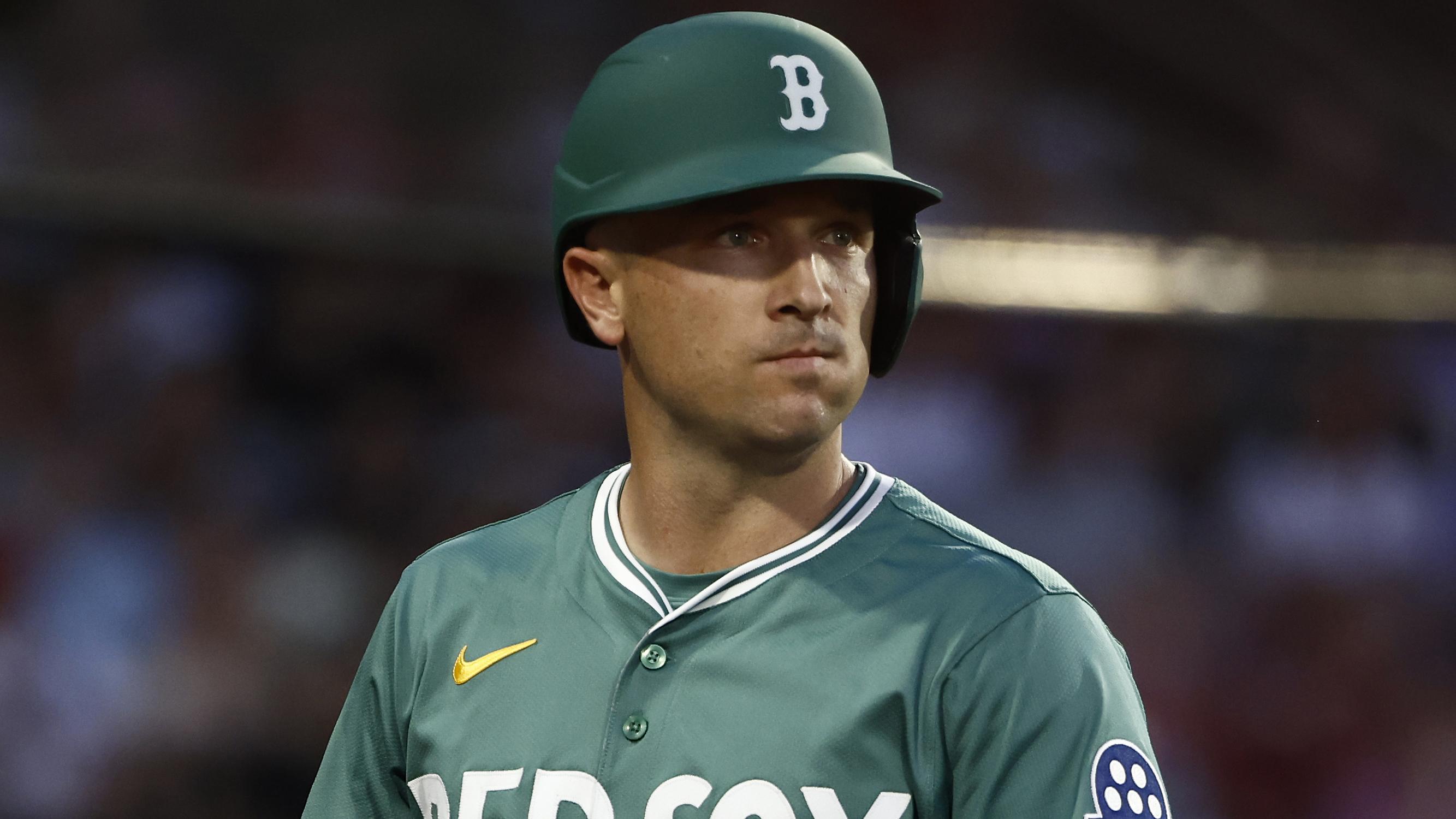Featured Video
ACUÑA HOMERS AGAIN 🫨
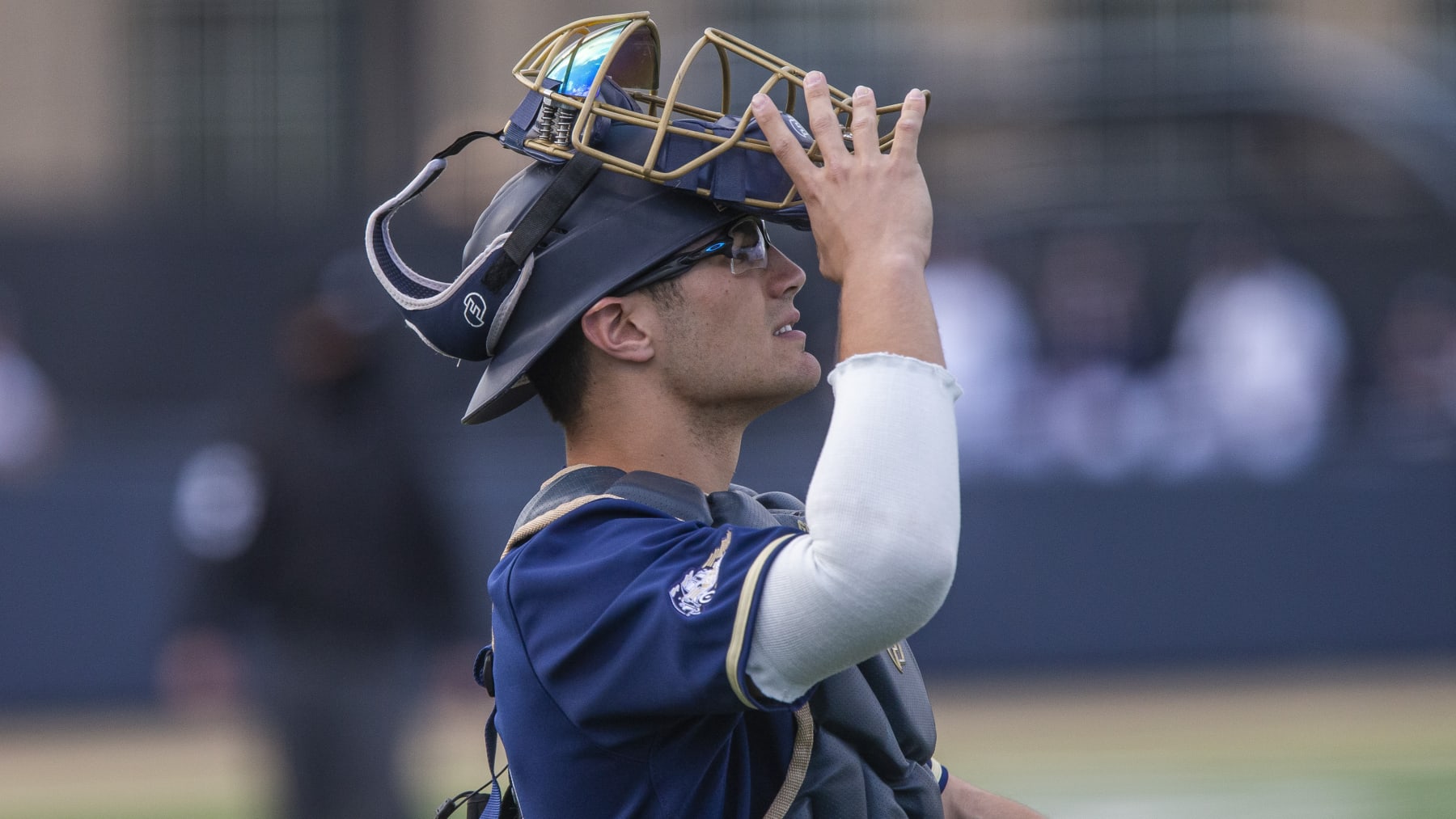
2022 MLB Draft Picks: Live Team-by-Team Day 1 Grades and Analysis
Welcome to Bleacher Report's 2022 MLB draft tracker!
For the second consecutive year, the draft is being held during All-Star weekend, with this year's event once again scheduled to span three days and 20 rounds. The first day will encompass the first 80 selections over the first and second rounds, as well as the competitive balance and compensatory picks slotted in between.
It's a unique draft class with an overall lack of high-end pitching talent due to several injuries at the high school and college levels.
However, a loaded crop of elite high school hitters gives this draft class a chance to be one we look back on years from now as a special group.
Keep it locked right here as Sunday's draft unfolds for scouting reports, grades and pick analysis for every Day 1 selection.
Note: My final Mock Draft published on Saturday morning can be found here.
Arizona Diamondbacks
1 of 30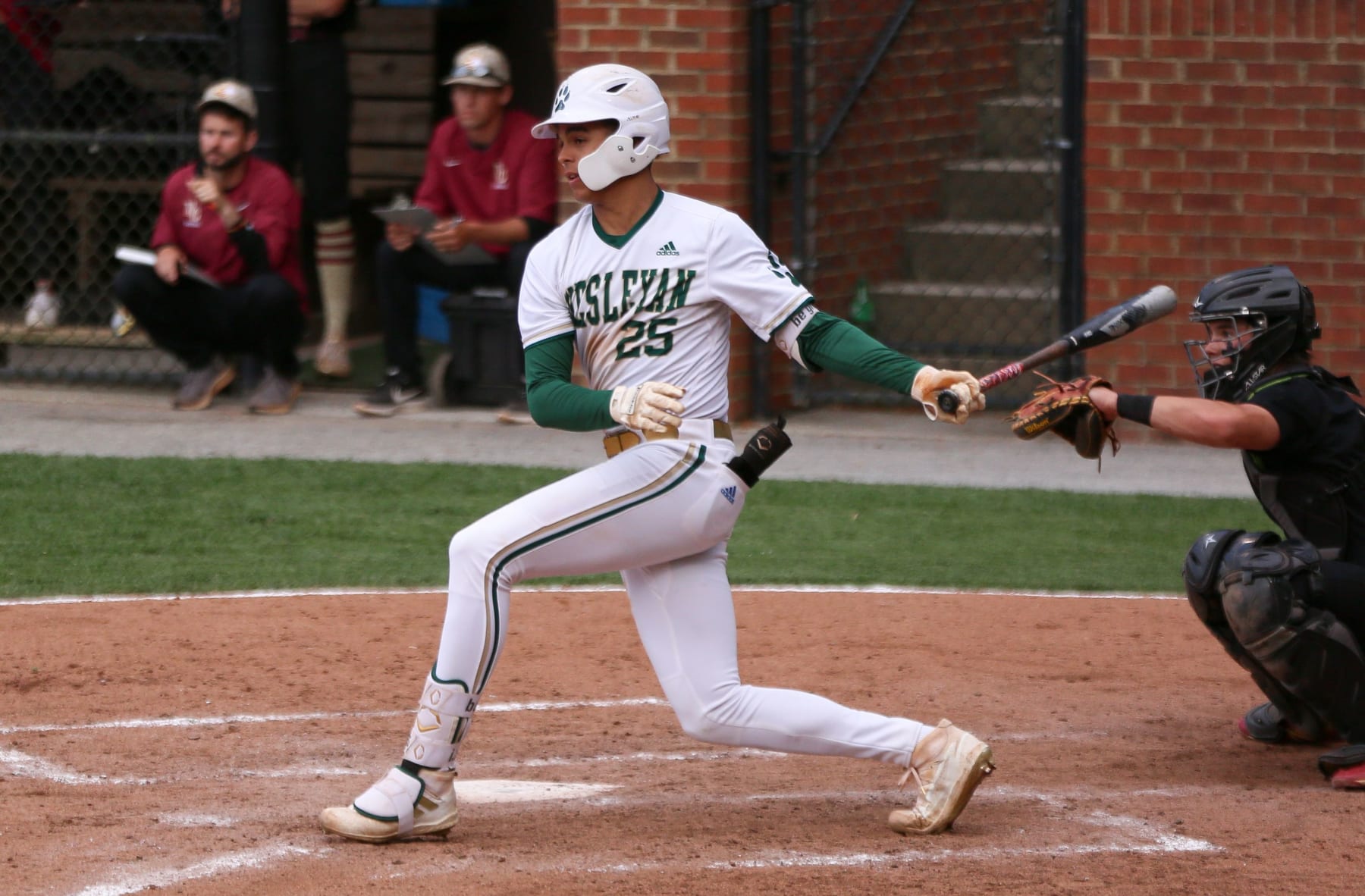
First Round (No. 2 Overall): Druw Jones, OF, Wesleyan School (GA)
Druw Jones does everything well with ample projection left in numerous facets of his game, most notably his power potential with room to grow into his 6'4", 180-pound frame. While he's far from a finished product offensively, there's a lot to like, and he makes hard contact. Aside from his bat, he has 70-grade speed and an elite glove in center field where his bloodlines are perhaps most evident as the son of 10-time Gold Glove winner Andruw Jones. He has some things to smooth out with his swing, and his power ceiling is still in question, but all signs point to a future as an All-Star center fielder.
Grade: A+
The consensus best player in this draft class at No. 2 overall. What more needs to be said? This feels a lot like 2012 when Byron Buxton was No. 1 on most draft boards, and the Houston Astros went with Carlos Correa instead. That worked out all right for everyone.
Balance Round A (No. 34 Overall): Landon Sims, RHP, Mississippi State
Landon Sims was one of the best relievers in the country in 2021, nailing down 13 saves while going 5-0 with a 1.44 ERA, 0.78 WHIP and 100 strikeouts in 56.1 innings. He moved into the starting rotation this spring and lasted three starts before blowing out his elbow and undergoing Tommy John surgery in March. His upper 90s fastball and wipeout slider would play at the back of an MLB bullpen right now, but with a strong 6'2", 227-pound frame and clean mechanics, he has starter potential if he can refine his changeup and avoid further arm issues.
Grade: A
A slam-dunk first-round pick before he was injured, Sims has major steal potential if he can make a smooth return to the mound. Even if he doesn't stick as a starter, his high reliever floor helps ease some risk.
Second Round (No. 43 Overall): Ivan Melendez, 1B, Texas
The 2022 Golden Spikes winner, Ivan Melendez annihilated collegiate pitching to the tune of a .387/.508/.863 line with a Division I-leading 32 home runs and 94 RBI in 67 games this spring while tallying more walks (52) than strikeouts (51). However, his profile as a right-handed-hitting, first-base-only prospect is among the riskiest of any draft candidate, and the fact that he is already 22 years old also works against him. He could be the next Pete Alonso or another in a long line of college sluggers with a similar profile who failed to make the leap to pro ball.
Grade: B+
If the D-backs were scared off by a right-right, first-base profile, they never would have drafted Paul Goldschmidt. There's big risk here, but there's also huge upside, and after nailing their first two picks, they could afford to take a big swing.
Atlanta Braves
2 of 30First Round (No. 20 Overall): Owen Murphy, RHP, Riverside-Brookfield High School (IL)
A two-way standout and Gatorade Player of the Year in Illinois, Owen Murphy logged a 0.12 ERA with 137 strikeouts in 58.1 innings and hit .548 with 18 home runs. He has Day 2 upside as a power-hitting infielder. However, with three quality offspeed pitches and a fastball velocity that has ticked up this spring, there's a much brighter future on the mound. A terrific run with the USA Baseball 18U National Team last summer proved he can thrive against high-level competition, and the only real knock is a 6'1", 190-pound frame that offers little remaining projection.
Grade: B
There's always a risk when it comes to cold-weather pitching prospects, but Murphy was a man among boys in Illinois, and his stock was trending up in a big way this spring. The Braves know how to develop pitching and got a great arm here.
Balance Round A (No. 35 Overall): J.R. Ritchie, RHP, Bainbridge High School (WA)
The reigning two-time Gatorade Player of the Year in Washington who posted a 0.30 ERA with a ridiculous 84-to-4 strikeout-to-walk ratio in 39.1 innings this spring, J.R. Ritchie has been on the MLB draft radar since a stellar showing on the showcase circuit as an underclassman in 2020. He has a 6'2", 185-pound frame and four pitches that can all flash plus at times, including a fastball that runs up to 97 mph. He also has good feel for spin on his curveball and a tight slider. There's always some risk with a cold-weather pitching prospect, but he checks all the boxes.
Grade: B+
In a thin draft for high school pitching, the Braves are taking an aggressive approach by scooping up two of the higher ceilings from that demographic. Pitching development is a strength, and they're doing a great job feeding into that.
Second Round (No. 57 Overall): Cole Phillips, RHP, Boerne High School (TX)
Cole Phillips was on his way to being one of the biggest pop-up prospects of the spring when he was flashing triple-digits on the radar gun, but that came to a screeching halt when he needed Tommy John surgery in April. He added strength to his 6'3", 200-pound frame between his junior and senior seasons, and his stuff ticked up across the board as a result. The question now is whether Phillips feels he can pitch his way into being a first-round prospect if he honors his commitment to Arkansas, and it will almost certainly take an above-slot deal to sign him.
Grade: A
The Braves came into the draft with a clear strategy and knocked it out of the park, scooping up three of the most promising prep pitchers in the country. Phillips could be a tough sign, but assuming they get it done, he could easily be the best of the three.
Compensation Round (No. 76 Overall): Blake Burkhalter, RHP, Auburn
Burkhalter finished second in Division-I with 16 saves this season while posting a 71-to-7 strikeout-to-walk ratio in 46.1 innings. With an undersized 6'0" frame and some effort in his delivery, he's destined for a role in the bullpen despite a solid three-pitch mix that includes a mid-90s fastball, a quality changeup and a developing cutter.
Grade: B
This was a reach, but the Braves needed a money-saving pick to help negotiate with their three high school pitchers. He should fly through the minors with some legitimate late-inning potential if his cutter continues to come along.
Baltimore Orioles
3 of 30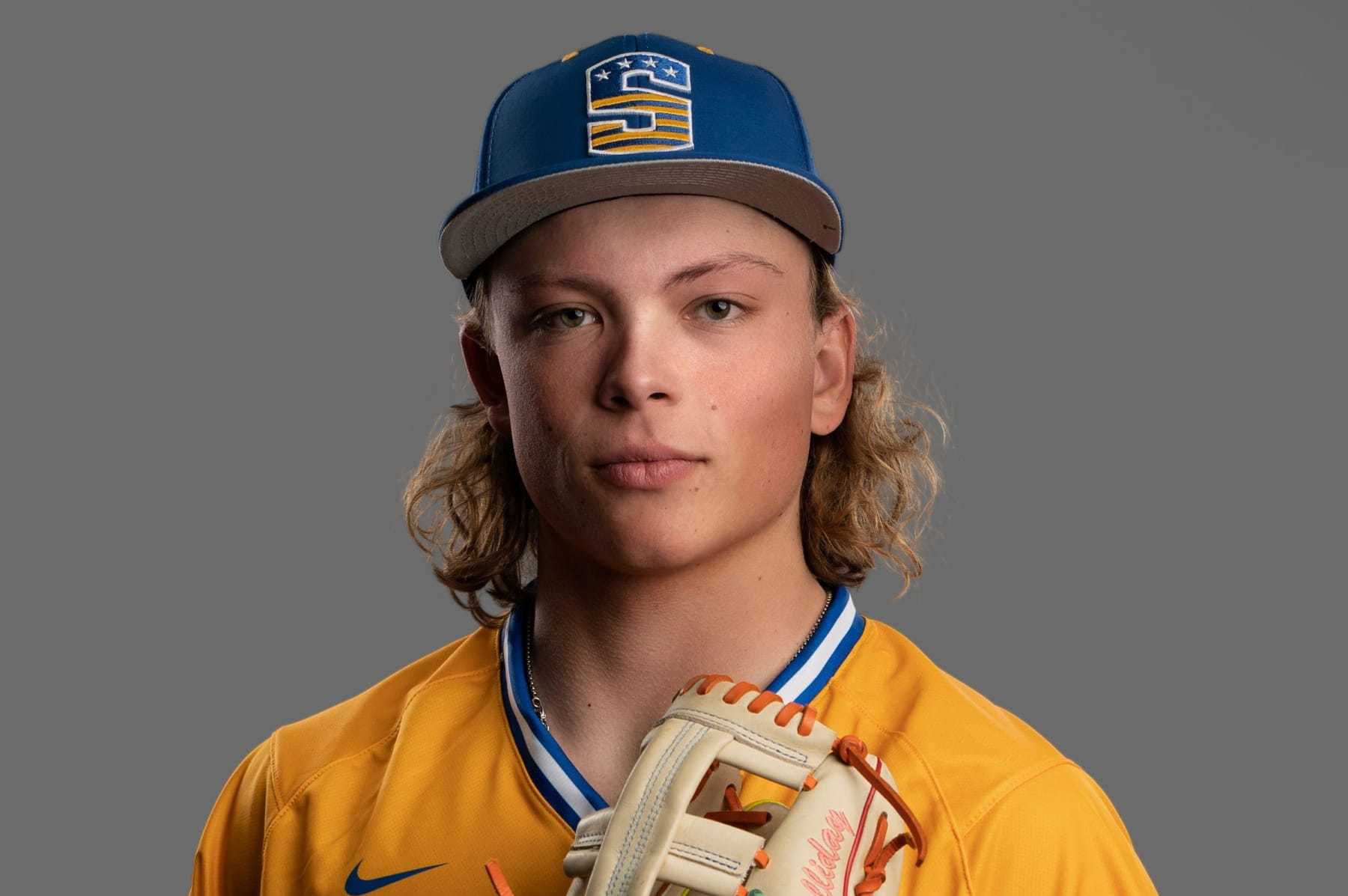
First Round (No. 1 Overall): Jackson Holliday, SS, Stillwater High School (OK)
Jackson Holliday hit an absurd .685/.749/1.392 this spring with 89 hits in 41 games to break J.T. Realmuto's national high school record for hits in a season. The son of former MLB All-Star Matt Holliday, he showed a more disciplined approach after selling out for power too often on the showcase circuit last summer. His offensive profile is more hit than power at present, but he has room to add strength to his athletic 6'1", 175-pound frame. With legitimate five-tool potential at the shortstop position, he has as high a ceiling as any player in the 2022 draft class.
Grade: B+
Holliday's stock climbed enough this spring that he had a legitimate case for being the best prospect in this class. Now we wait and see what Druw Jones turns into...
Balance Round A (No. 33 Overall): Dylan Beavers, OF, California
One of the top power hitters in the nation as a sophomore when he posted a 1.031 OPS with 18 home runs, Dylan Beavers also struck out 53 times in 55 games. He continued to strike out at roughly a 20 percent rate this spring, but he also showed a more disciplined approach, raising his walk rate from 12.7 to 18.8 percent. The 6'4", 206-pound outfielder has four plus tools beyond his hit tool, giving him a higher floor than most swing-and-miss sluggers, but his ability to make consistent contact will determine his ceiling.
Grade: A
Beavers was a popular mock pick for Oakland at No. 19 overall, so this is a great value relative to expectations. If he can continue refining his approach, he can be a major offensive force.
Second Round (No. 42 Overall): Max Wagner, 3B, Clemson
The ACC Player of the Year and one of the breakout performers of the 2022 college season, Max Wagner hit a gaudy .370/.496/.852 with 27 home runs and 76 RBI in 58 games. His limited track record gives some reason for pause, and his power is generated more with strength than bat speed, but it's tough to ignore what he did this spring. A solid glove at third base adds auxiliary value beyond his power production, and he hit .313/.485/.566 in 132 plate appearances swinging wood bats in the Northwoods League last summer.
Grade: A
Have a day, Orioles! It's easy to dream on a future infield of Ryan Mountcastle, Gunnar Henderson, Jackson Holliday and Wagner as they steadily build their way toward legitimate contention.
Balance Round B (No. 67 Overall): Jud Fabian, OF, Florida
Jud Fabian failed to come to terms with the Boston Red Sox as a second-round pick last year and returned to Florida for his senior season. The 6'1", 195-pound slugger has launched 44 home runs the past two seasons, but the swing-and-miss concerns that plagued him in 2021 continued this spring. Despite marked improvements to his strikeout rate (minus-7.1 percentage points) and walk rate (plus-5.1), he batted just .239. He has some of the best raw power in college baseball, but he's as much of a boom-or-bust prospect as anyone in the 2022 class.
Grade: B+
After going No. 40 overall in the 2021 draft, Fabian returned to school and wound up sliding 27 picks further. With as much raw power as any player in this class, he's well worth a roll of the dice this late.
Boston Red Sox
4 of 30First Round (No. 24 Overall): Mikey Romero, SS, Orange Lutheran High School (CA)
Mikey Romero struggled early this spring playing for California prep powerhouse Orange Lutheran, but he rounded into form as the season progressed. He has a good approach at the plate with quick hands and a smooth left-handed swing, but he'll need to add significant strength to his 6'1", 175-pound frame to be an impact player offensively. He's a safe bet to stick at shortstop with a strong arm and good range, which adds to his long-term outlook.
Grade: C
I scratched my head when the Red Sox reached for Nick Yorke in 2020, and that decision has worked out pretty well for them, but this still feels like a reach and a bit of a low upside play relative to some of the other players on the board.
Second Round (No. 41 Overall): Cutter Coffey, SS, Liberty High School (CA)
Coffey has reached up to 94 mph on the mound, and he was one of the better two-way players on the showcase circuit last summer, but his pro future is in the batter's box and on the left side of the infield. He has a power-over-contact offensive profile at present, but he holds his own against off-speed stuff, and there's potential for his hit tool to improve as he matures. He played shortstop for his high school team and could get a look there, but third base is a more likely long-term landing spot.
Grade: C
I like a draft strategy with some balance, especially for a team like the Red Sox that is thin on pitching talent down on the farm. Stocking up on second-tier prep shortstops is the opposite of a balanced approach.
Compensation Round (No. 79 Overall): Roman Anthony, OF, Stoneman Douglas High School (FL)
A 6'3", 200-pound slugger with room to add even more strength to his frame, Roman Anthony can put on a show in batting practice. The question is whether that will translate to games, and he showed considerable swing-and-miss on the showcase circuit last summer. He made more consistent contact this spring and had some late helium as a result, but he is still the prototypical power-over-hit prep prospect who comes with significant risk.
Grade: B
Another risky high school pick, but I think Anthony has a higher ceiling than either of the players the Red Sox drafted ahead of him. Expect to see a lot of college guys on Day 2.
Chicago Cubs
5 of 30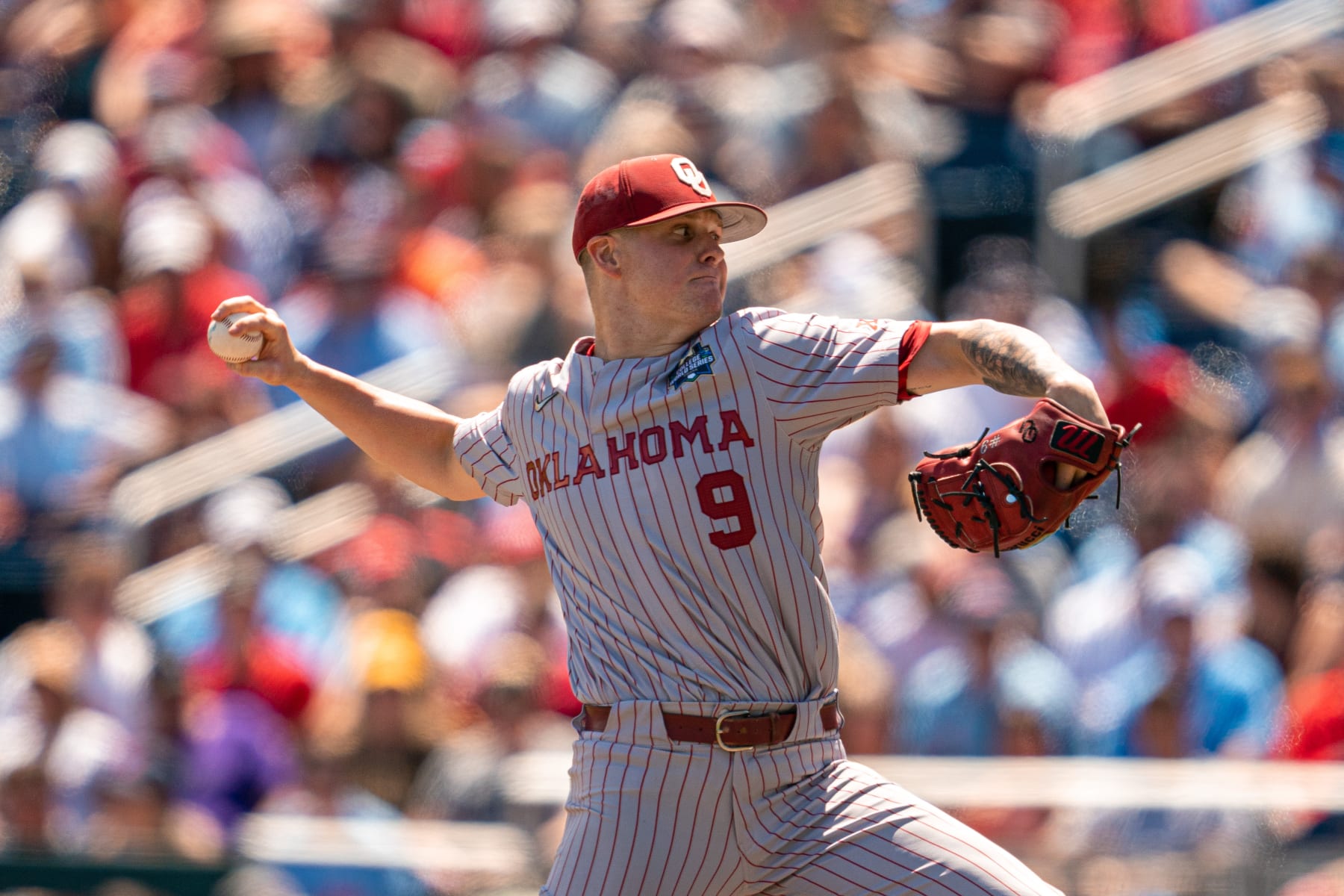
First Round (No. 7 Overall): Cade Horton, RHP, Oklahoma
The breakout prospect of this year's College World Series, Cade Horton finished the regular season with a 7.94 ERA while seeing more time at third base than he did on the mound, but he sent his stock soaring with a 2.61 ERA and 49 strikeouts in 31 innings over five postseason starts. The athleticism that made him a two-way contributor is apparent in his clean, repeatable mechanics, and his fastball-slider combination stacks up to any two-pitch mix in the class. After missing all of his freshman season recovering from Tommy John surgery, his track record is extremely limited, but his arrow is pointing straight up.
Grade: C
Between Horton's limited collegiate success and the Cubs' abysmal recent track record developing pitching, this is a tough one to understand. It looks an awful lot like what the Kansas City Royals did picking at No. 7 overall last year when they reached for Frank Mozzicato to save money for later in the draft, so stay tuned.
Second Round (No. 47 Overall): Jackson Ferris, LHP, IMG Academy (FL)
Jackson Ferris has electric stuff with a fastball that touches 97 mph, the potential for two plus offspeed pitches in a high-spin curveball and a good feel for a changeup. However, there are a lot of moving parts to his delivery that can work in his favor in terms of deception and against him when he gets out of sync, leaving his command to suffer. His 6'4", 195-pound frame offers further physical projection, and he has performed well against high-level competition, but he carries more risk than some of the other top high school arms in the class.
Grade: A
The reach for Horton looks infinitely better now that the Cubs have also walked away with one of the top high school arms in the class. They should have no problem making an above-slot deal work here.
Chicago White Sox
6 of 30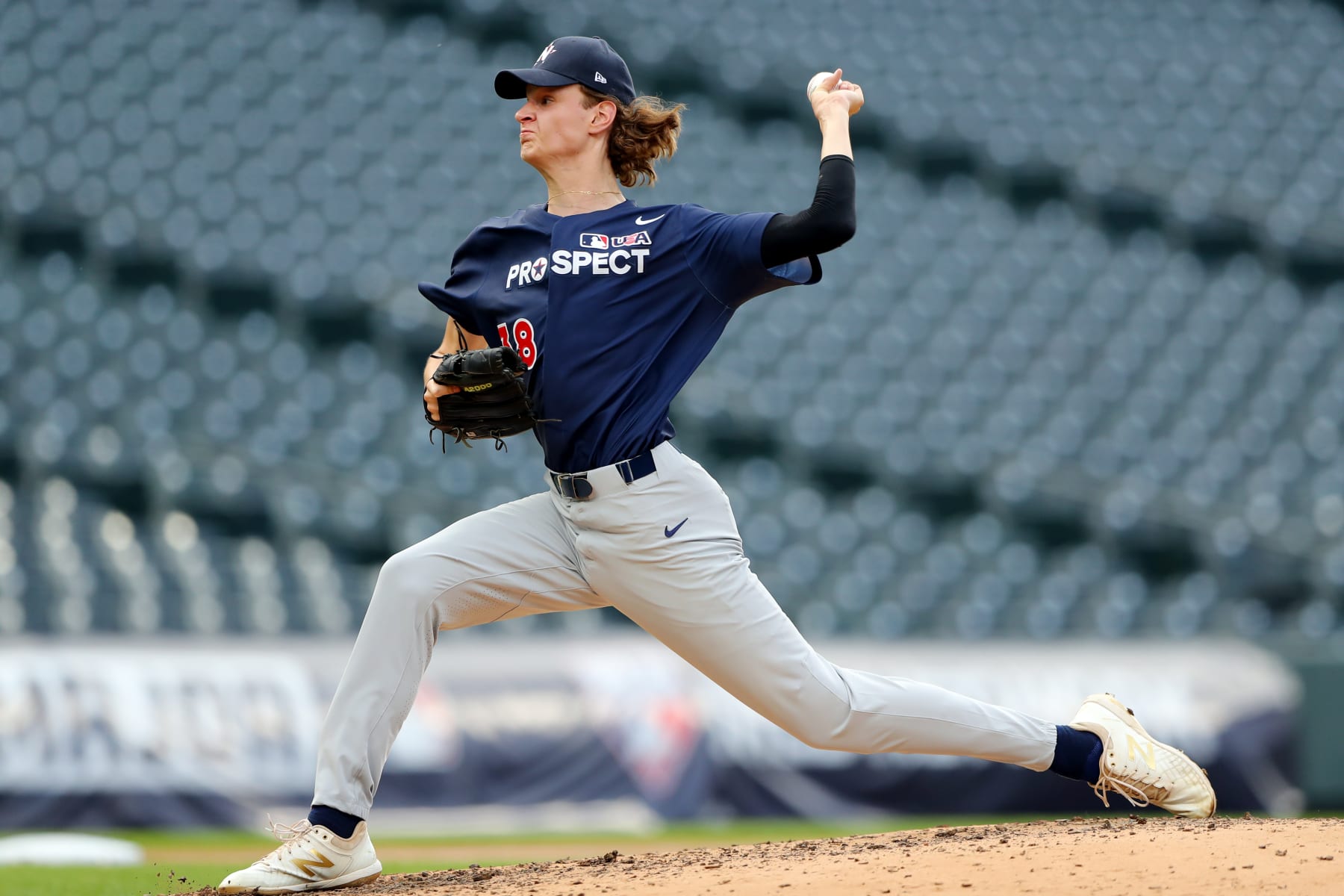
First Round (No. 26 Overall): Noah Schultz, LHP, Oswego East High School (IL)
A highly projectable 6'9", 220-pound southpaw, Noah Schultz missed a significant chunk of his senior season recovering from mononucleosis, and scouts didn't get to see much of him in general pitching in a cold-weather state. A mid-90s fastball, excellent slider, and the potential for more as he grows into his frame is tantalizing. He's also a rare athlete for his size and does a great job repeating his mechanics. He's expected to be a tough sign away from his commitment to Vanderbilt.
Grade: B
Schultz played his high school ball about 40 miles from Guaranteed Rate Field, so the White Sox had as good an opportunity as anyone to see his limited action this spring. That makes me more confident of a solid grade than I would have been for other teams.
Second Round (No. 62 Overall): Peyton Pallette, RHP, Arkansas
Yet another high-end college arm who watched the 2022 season from the sidelines, Peyton Pallette saw his 2021 season cut short by elbow problems. After trying to rehab the injury, he eventually underwent Tommy John surgery in January. All told, he pitched just 61.2 innings in his time at Arkansas, posting a 3.79 ERA with 23 walks and 70 strikeouts. Despite a slight 6'1", 180-pound frame he has three potential plus pitches, including a high-spin hammer curveball that is a true swing-and-miss offering. He's upside over results, but the pre-injury stuff was hard to ignore.
Grade: B+
The White Sox have shown a willingness to fast track pitchers in a relief role, even if they intend to develop them as a starter. Pallette was a potential first-round pick prior to his injury, and he could follow a similar path once he returns to the mound.
Cincinnati Reds
7 of 30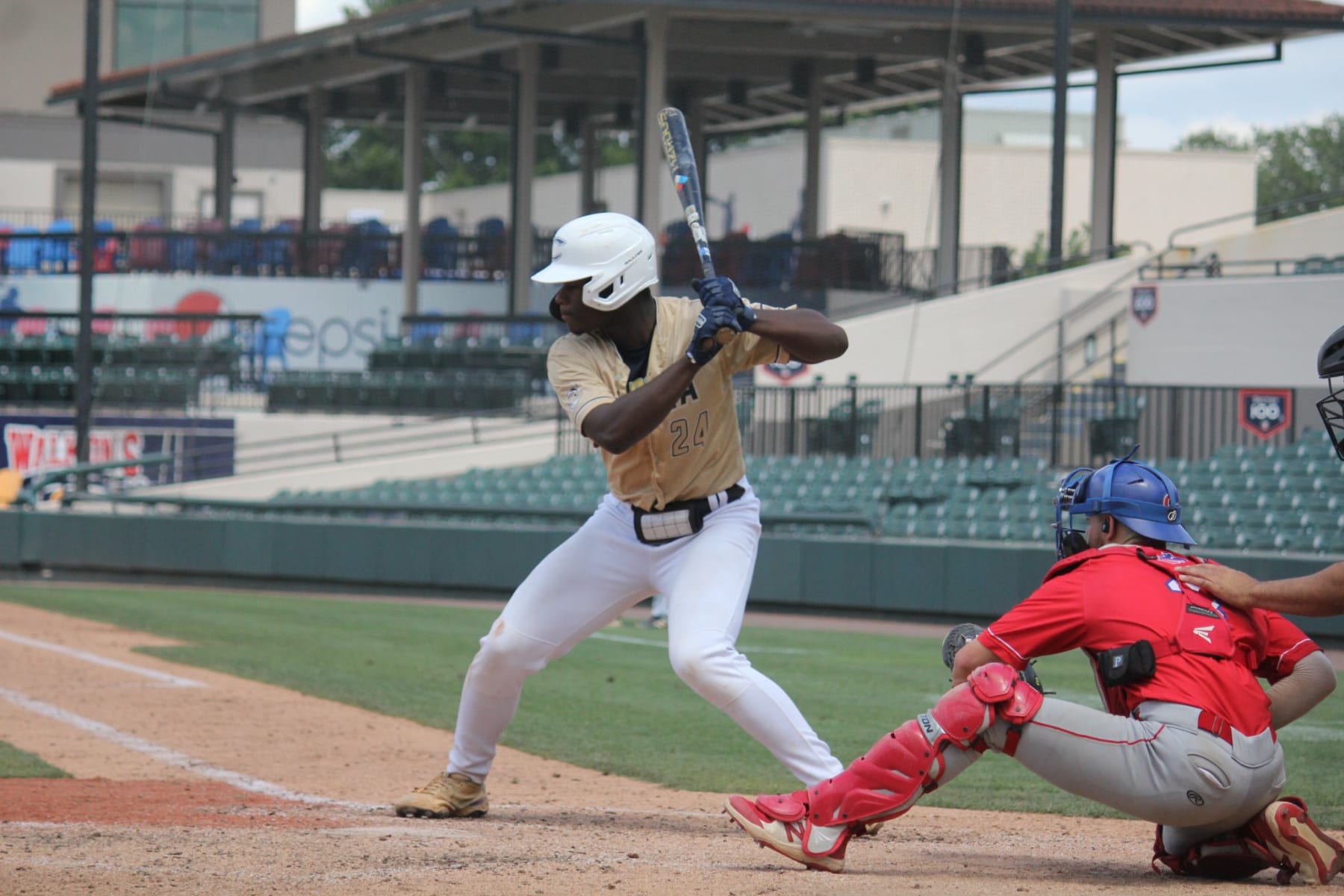
First Round (No. 18 Overall): Cam Collier, 3B, Chipola College (FL)
Originally one of the top prospects in the 2023 draft class, Cam Collier reclassified, got his GED and enrolled at JUCO powerhouse Chipola College this spring, where he hit .333/.419/.537 with 20 extra-base hits and 47 RBI in 52 games. The son of former MLB utility man Lou Collier, he has one of the best hit tools in the class and plenty of untapped power in his 6'2", 210-pound frame. With an arm that delivered low-90s fastballs on the mound and solid athleticism, he should have no problem sticking at the hot corner. A JUCO hitter has not been taken in the first round since Chicago White Sox shortstop Tim Anderson in 2013.
Grade: A+
I had Collier going No. 4 overall in my final mock draft, so clearly, I'm a fan of the value here in the back half of the first round. He's going to take some time in the minors to develop, but the payoff could be an All-Star third baseman.
Compensation Round (No. 32 Overall): Sal Stewart, 3B, Westminster Christian School (FL)
With a strong 6'3", 215-pound frame and a long track record of success on the showcase circuit, Sal Stewart is one of the better power bats among this year's high school crop. He showed an improved hit tool this spring to go along with 60-grade raw power, and there's reason to believe he can be a well-rounded offensive player rather than just a masher. Despite being a below-average athlete, he has good hands and solid footwork at third base, which should allow him to begin his pro career at the hot corner.
Grade: C
The Reds love betting on power over polished, evidenced by the picks of Rece Hinds and Austin Hendrick in recent years, but that hasn't necessarily worked out to this point. Maybe this saves them some money against slot to get Collier signed?
Second Round (No. 55 Overall): Logan Tanner, C, Mississippi State
A two-way prospect in high school who was up to 96 mph with his fastball, Logan Tanner has a top-of-the-scale arm that can shut down the opposing running game. After a 15-homer sophomore campaign, his slugging percentage dropped 100 points as a junior, but his strength and bat speed still provide intriguing power potential. His defensive tools give him a relatively high floor as a backup catcher, and his power-over-contact offensive profile will determine his ceiling.
Grade: C
This year's catching class was relatively thin, and Tanner is good enough with the glove to be a useful organizational piece even if his bat never comes around. I would have liked the pick better in the third round, but there's some upside here.
Balance Round B (No. 73 Overall): Justin Boyd, OF, Oregon State
Boyd didn't play at all in 2020 and was a part-time player in 2021 when he tallied just 88 plate appearances, but he put together a breakout junior season to fly up draft boards playing alongside Jacob Melton in the Beavers' outfield. He hit .373/.490/.577 with 27 extra-base hits and 24 steals this spring, and he also has plus speed and a good glove in the outfield. After a pop-up performance this spring, he has more remaining upside than most college hitters.
Grade: B+
I love grabbing a player on the upswing here after doing the opposite with their last pick. They're doing something right when it comes to developing outfielders.
Cleveland Guardians
8 of 30
First Round (No. 16 Overall): Chase DeLauter, OF, James Madison
With a strong 6'4", 235-pound frame, Chase DeLauter looks the part of a middle-of-the-order slugger. His junior season at James Madison was cut short when he broke his foot in April, but he batted .437/.576/.828 with 17 extra-base hits and 10 steals in 24 games prior to the injury. He went 3-for-14 with eight strikeouts against some good Florida State pitching in the season-opening series, raising questions about his ability to hit high-level pitching, but he also posted a .986 OPS with nine home runs in the Cape Cod League last summer.
Grade: C
I did not expect DeLauter to be the first college outfielder taken after Gavin Cross, but it's not surprising the Guardians were enamored as a team that likes to target loud carrying tools. Can he hit quality pitching?
Balance Round A (No. 37 Overall): Justin Campbell, RHP, Oklahoma State
After pulling double duty as a weekend starter and designated hitter in 2021, Justin Campbell focused solely on pitching this spring and went 9-2 with a 3.82 ERA, 1.07 WHIP and 141 strikeouts in 101.1 innings. The 6'7" right-hander gets good late movement on his fastball and hides his pitches well from a high three-quarters arm slot. He has four average-or-better offerings and excellent command—just 25 walks this spring—giving him a high floor as a back-of-the-rotation starter.
Grade: A
The Guardians took a similar pitcher in terms of high-floor and polish in Tanner Burns with the No. 36 pick in the 2020 draft, and he's having a great season at Double-A. They know how to get the most out of guys who can consistently throw strikes.
Second Round (No. 54 Overall): Parker Messick, LHP, Florida State
Parker Messick pitched his way into the Friday starter role for Florida State in 2021, and he continued to impress atop the rotation this spring with a 3.38 ERA, 0.97 WHIP and a terrific 144-to-18 strikeout-to-walk ratio in 98.2 innings. He has a strong 6'0", 225-pound frame, and he pounds the zone with strikes while keeping hitters off-balance with a polished four-pitch mix. He's more pitchability than upside, but he should be able to stick as a starter, and his plus command gives him a very high floor.
Grade: B+
Another high-floor strike-thrower who fits the mold the Guardians have targeted over the years. He's the type of pitcher who will exceed expectations in the Cleveland system.
Colorado Rockies
9 of 30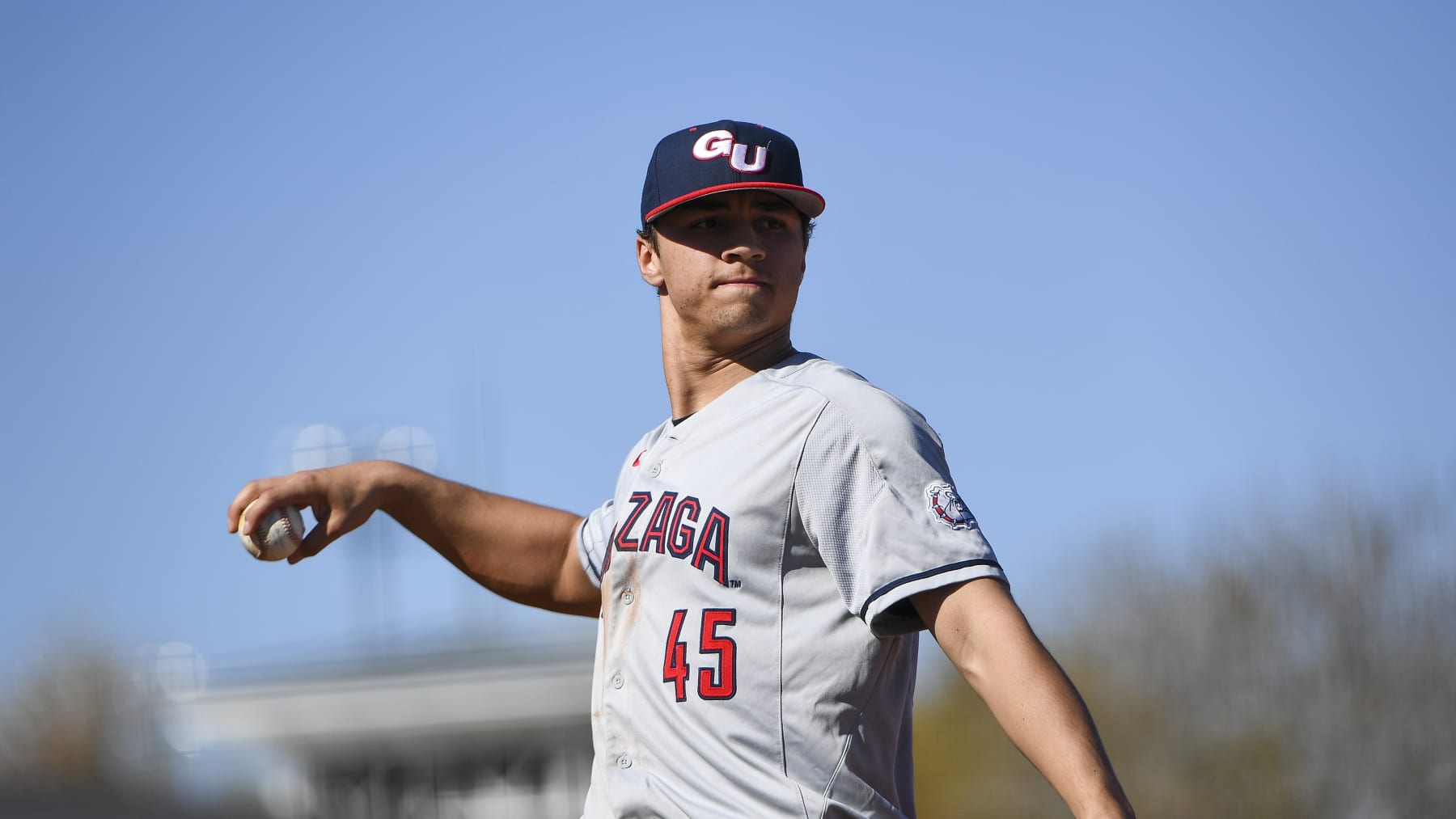
First Round (No. 10 Overall): Gabriel Hughes, RHP, Gonzaga
One of the few top-tier college pitchers who were healthy and productive for the entirety of the 2022 campaign, Gabriel Hughes went 8-3 with a 3.21 ERA, 1.15 WHIP and 138 strikeouts in 98 innings. The 6'4", 220-pound right-hander has a mid-90s fastball that can brush triple-digits and a wipeout slider that sits in the low 90s and is a legitimate putaway pitch. He threw a dud against Columbia (6.0 IP, 9 H, 6 ER) in his final start of the season, but there's a lot to like about his long-term upside as a potential workhorse starter with a high floor.
Grade: A
Every year I find myself giving the Rockies a low grade when they ignore their need for pitching in favor of another corner infielder, so it's only fair to give them the "A" grade after they finally took an arm. They went floor over ceiling here, and that's perfectly fine.
Compensation Round (No. 31 Overall): Sterlin Thompson, OF, Florida
A draft-eligible sophomore and one of the best pure hitters in the country, Sterlin Thompson shares some similarities to 2020 first-round pick Garrett Mitchell as a polished hitter who is still working to tap into his power potential. The 6'4", 200-pound outfielder hit .354/.443/.563 with 16 doubles, 11 home runs and 51 RBI this spring, raising his OPS by 140 points. He saw time at second base in college, but a corner outfield spot is his most likely fit at the next level.
Grade: B
I suppose it was wishful thinking for the Rockies to take two pitchers to kick off their draft class, especially with so many college bats still on the board. Good value here on a guy most expected to go somewhere in the 20s.
Balance Round A (No. 38 Overall): Jordan Beck, OF, Tennessee
Jordan Beck stands out for his impressive combination of power, speed and athleticism. The 6'3", 225-pound outfielder posted a .986 OPS with 18 home runs and 61 RBI in 66 games this spring. However, questions remain about his hit tool and overall approach at the plate after he posted a 62-to-37 strikeout-to-walk ratio in 297 plate appearances, and he fits the risky 45-hit, plus-power profile. He did make improvements this year, raising his on-base percentage from .336 to .391 without sacrificing any power, and he should also provide value as a good defensive outfielder.
Grade: D
This is more like what we've come to expect from the Rockies. There's good potential value here, but taking two college outfielders in the top-40 picks is a bad draft strategy for a team that will always need to rely on homegrown pitching since attracting top arms in free agency is a non-starter.
Second Round (No. 50 Overall): Jackson Cox, RHP, Toutle Lake High School (WA)
Jackson Cox has one of the best curveballs in the 2022 class, a high-spin offering that eclipses 3,000 rpm and can buckle opposing hitters. He has also been up to 96 mph with his fastball and has shown some feel for a changeup. HIs athleticism helps make up for an undersized 6'1", 185-pound frame, and he repeats his mechanics well, though there are some things to iron out with his delivery. Scouts didn't see a ton of him this spring pitching in cold-weather Washington, but his present stuff stacks up to any prep right-hander outside of Brock Porter and Dylan Lesko.
Grade: B+
Now we're talking! German Marquez has found success with the Rockies pitching off of one of the best curveballs in baseball, so there's reason to be optimistic about this fit. We'll focus on that example of a curveball specialist rather than 2016 fourth overall pick Riley Pint...
Detroit Tigers
10 of 30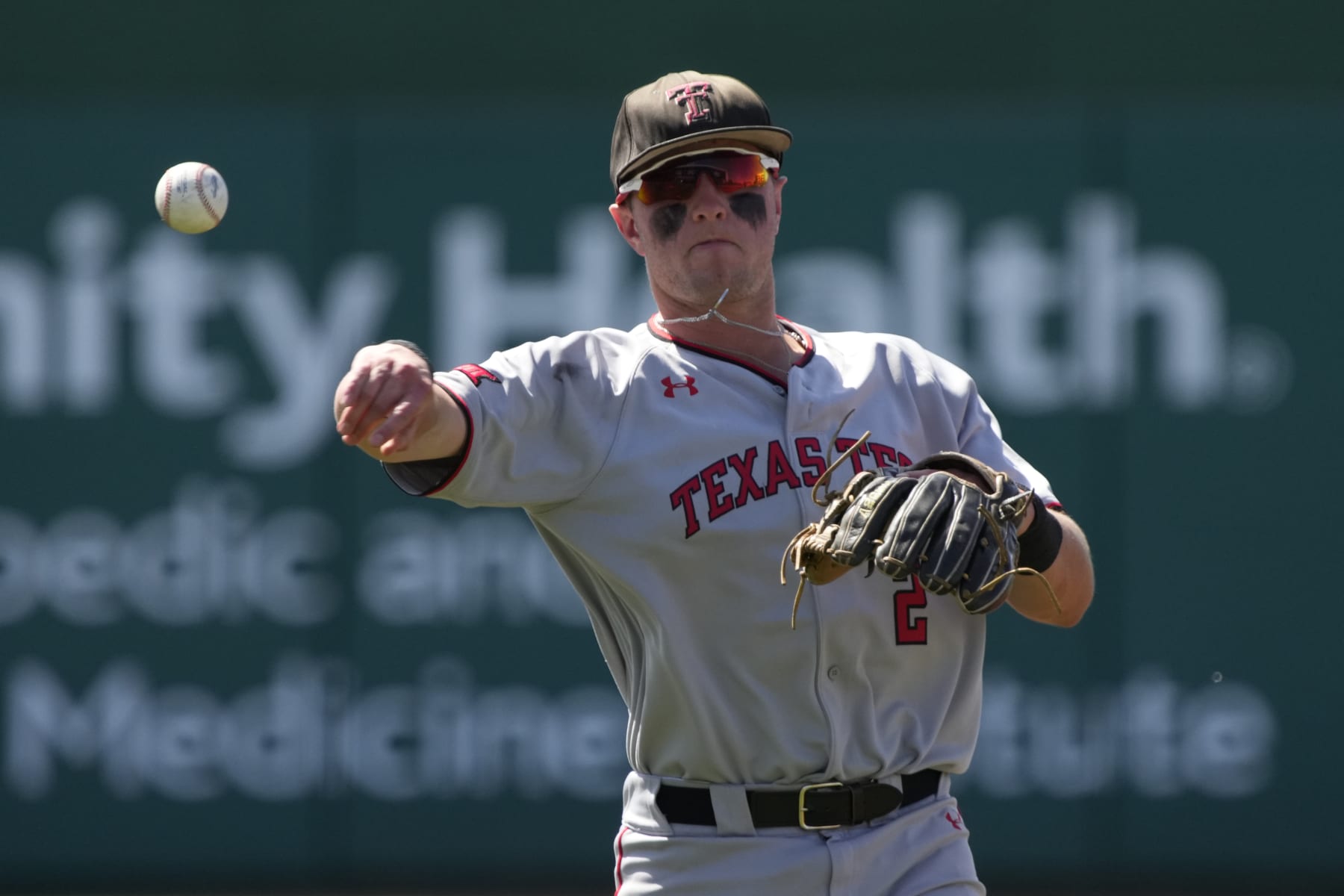
First Round (No. 12 Overall): Jace Jung, 2B, Texas Tech
One of the most accomplished hitters in the nation, Jace Jung batted .328/.468/.647 with 39 home runs, 147 RBI and more walks (126) than strikeouts (102) in 136 career games at Texas Tech. Despite an unorthodox stance, he is one of the best pure hitters in the class with a 60-hit/60-power offensive profile that should translate well to the next level. He has power to all fields and an advanced overall approach, though his swing can get long at times. Most of his value will come from his bat as he profiles as an average-at-best defender at second base and third base and doesn't run particularly well, but he could be a .300 average and 30-homer guy.
Grade: B
It's not out of the question to think that Jung could be in the majors by late 2023 or early 2024, which lines up well with what the Tigers are building. His late-season struggles are a legitimate concern, but this is good value.
Second Round (No. 51 Overall): Peyton Graham, SS, Oklahoma
One of the most improved players in college baseball, Peyton Graham raised his OPS over 100 points this spring while hitting .335/.417/.640 with 20 home runs, 71 RBI and 34 steals in 36 attempts, all while successfully making the shift from third base to shortstop. He also saw time in the outfield during the Cape Cod League last summer, and his versatility no doubt adds to his appeal. There are some concerns about his hit tool, and he struck out 69 times in 67 games this season, but his diverse toolbox gives him impact upside.
Grade: B
The Tigers clearly think their window is opening soon, targeting a pair of college bats at the top of this class, and they got two of the nation's most productive hitters.
Houston Astros
11 of 30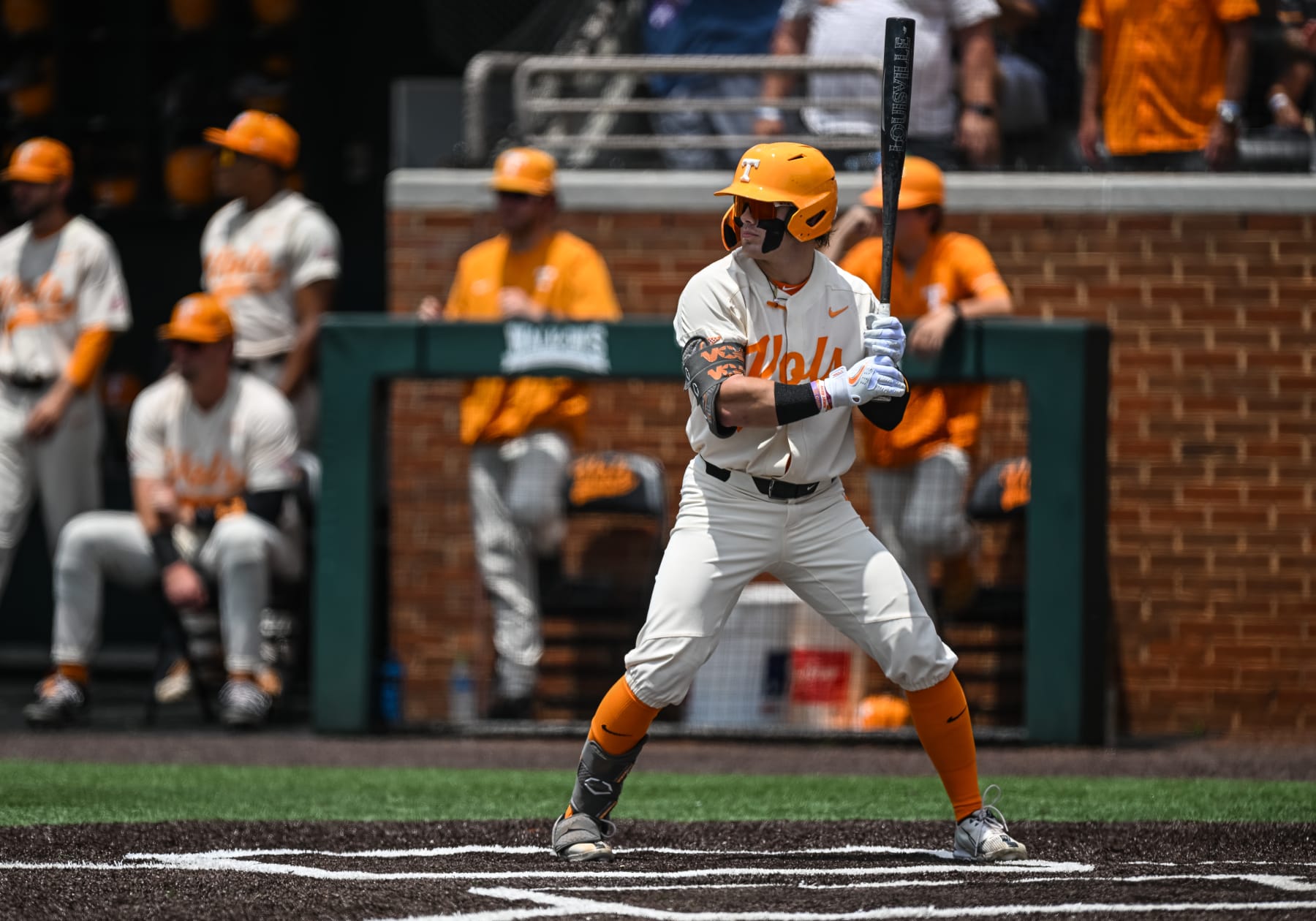
First Round (No. 28 Overall): Drew Gilbert, OF, Tennessee
Few college hitters did more to boost their draft stock this spring than Drew Gilbert. The 21-year-old hit .362/.455/.673 with 21 doubles, 11 home runs and 70 RBI, improving his OPS by more than 300 points from his sophomore numbers. His 5'9" frame raises questions about his long-term power potential, but he has quick hands and finds the barrel frequently. He has also been up to 93 mph pitching in relief, and that strong arm plays well in the outfield where he is one of the few clean fits in center field in a deep crop of collegiate corner outfielders.
Grade: C
So many power arms still on the board, and the Astros draft a high-floor center fielder? Nothing against Gilbert, who was one of the breakout stars of the college season, but I would have loved to see what the Astros' developmental team could do with Connor Prielipp or Carson Whisenhunt.
Second Round (No. 64 Overall): Jacob Melton, OF, Oregon State
Jacob Melton hit .360/.424/.671 with 22 doubles, 17 home runs, 83 RBI and 21 steals in 22 attempts during a breakout performance this spring while taking over as the starting center fielder for a good Oregon State team. He has a well-rounded toolbox with the potential for a plus hit and plus power tool if he continues on his developmental path, and he should be able to stay up the middle in pro ball. The fact that he turns 22 years old in September works against him in some draft models, but he's a prospect on the rise.
Grade: A
The Astros had a second chance to grab Whisenhunt here and passed him up again, but the value they get in Melton this late is impossible to give anything but an "A" grade. Don't be surprised if he winds up being the best of this year's deep college outfielder class.
Compensation Round (No. 80 Overall): Andrew Taylor, RHP, Central Michigan
An All-American this spring at Central Michigan, Taylor finished 8-4 with a school-record 126 strikeouts in 84 innings. In his three years on campus, he limited opposing hitters to a .194 average in 195 innings. With a lanky 6'5", 190-pound frame, there is some hope that he can add a little more to a fastball that sits in the low 90s and touches 94 mph, though there are also health concerns after he left starts earlier in the year with elbow tightness.
Grade: B
Nice to see the Astros finally get an arm and one with some intriguing upside left despite coming from the college ranks.
Kansas City Royals
12 of 30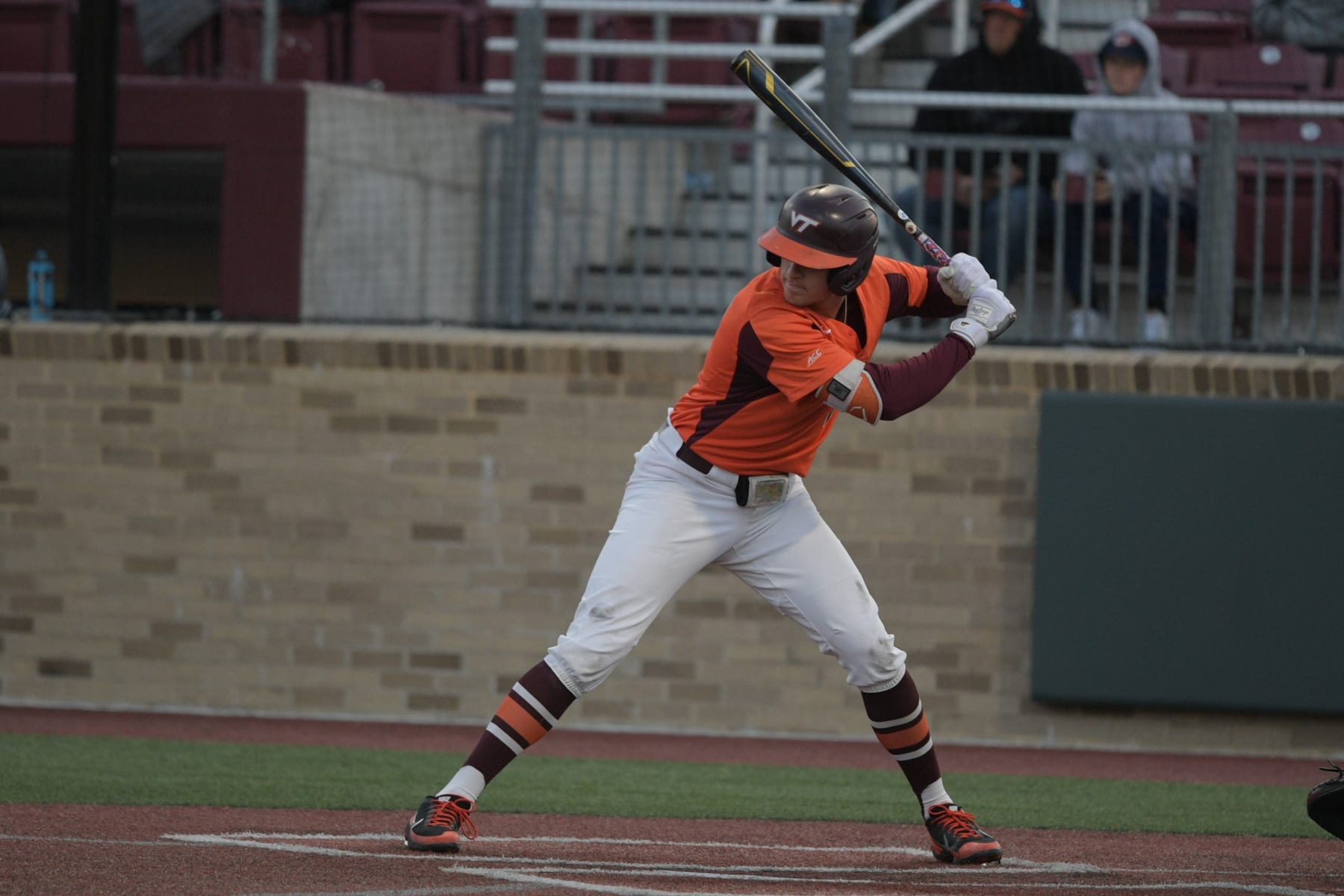
First Round (No. 9 Overall): Gavin Cross, OF, Virginia Tech
Gavin Cross hit .345/.415/.621 with 11 home runs during a breakout 2021 season and followed that up with a terrific run with Team USA over the summer, putting him squarely in the first-round conversation entering his junior year. He continued to impress this spring, hitting .328/.411/.660 with 17 home runs, 50 RBI and 12 steals to cement his status as one of the elite college hitters in the 2022 class. While he has played center field at Virginia Tech, he'll likely shift to a corner spot as a pro, and he has the offensive profile and the arm strength to be a clean fit in right field.
Grade: B+
The present and future of the Royals outfield is a major question mark, and this helps plug at least one hole in the long-term picture. Cross is a relatively safe pick with impact upside, and that's the type of player the Royals should be targeting at this stage in their rebuild.
Second Round (No. 49 Overall): Cayden Wallace, 3B, Arkansas
Cayden Wallace has a lot of playable tools, starting with a rocket arm and impressive raw power that resulted in 20 doubles, 16 home runs and tantalizing exit velocity readings this spring for an Arkansas team that reached the College World Series. He also stole 12 bases in 13 attempts and walked at an 11.8 percent clip. He has a pull-heavy approach, and he struck out 56 times in 67 games to raise some questions about his future hit tool, but he's capable of providing value in a variety of ways even if he doesn't hit for a high average.
Grade: B
The Royals have been searching for a long-term answer at third base since Mike Moustakas was traded in 2018, and this might be their solution. He'll need to continue to refine his approach, but the raw power is there for him to be a middle-of-the-order slugger.
Los Angeles Angels
13 of 30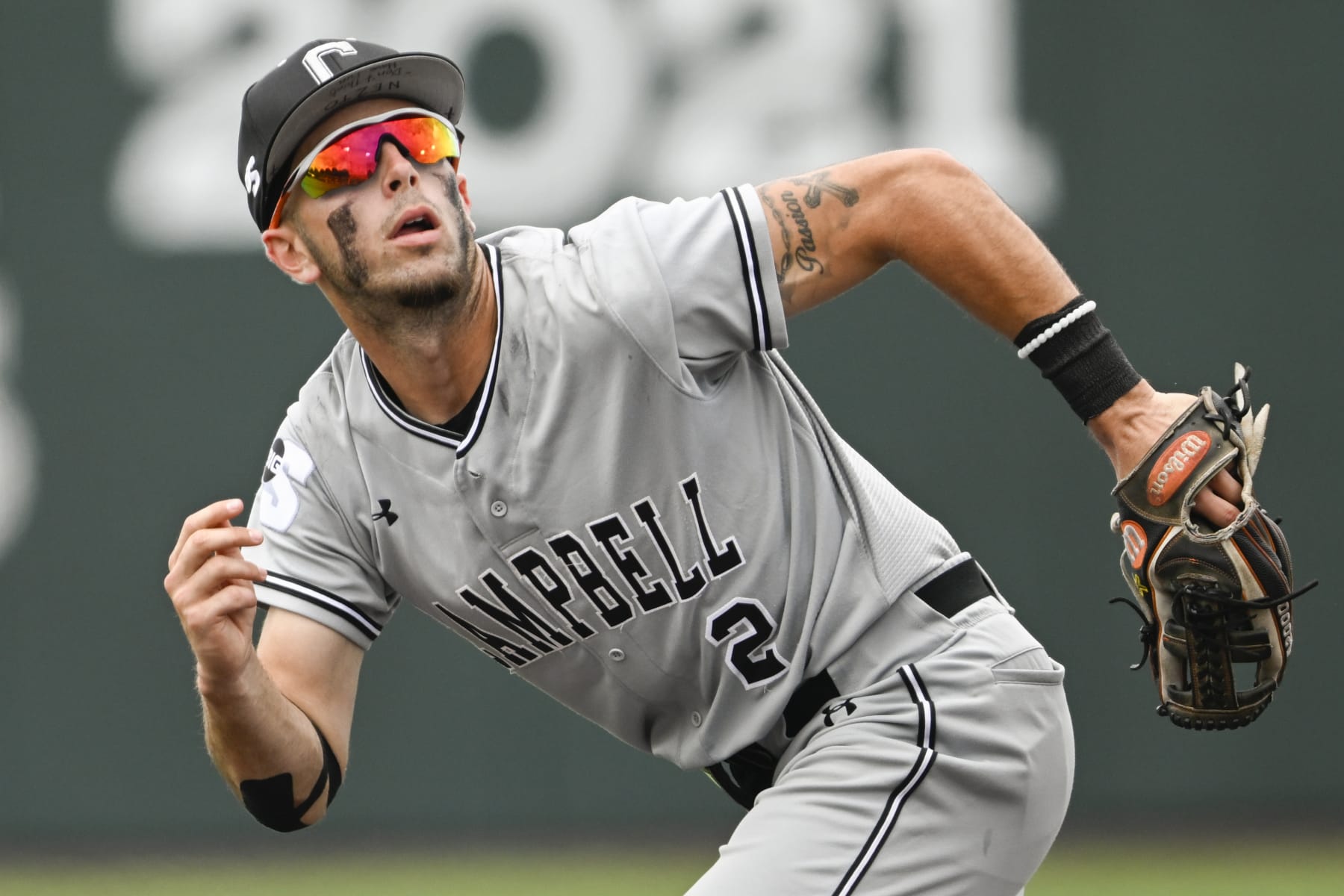
First Round (No. 13 Overall): Zach Neto, SS, Campbell
The Big South Player of the Year in 2021 (.405 BA, 1.234 OPS, 32 XBH) and 2022 (.407 BA, 1.283 OPS, 40 XBH), Zach Neto proved himself against tougher competition last summer when he hit .304/.439/.587 with three home runs in 57 plate appearances in the Cape Cod League. He has a lot of moving parts to his setup at the plate, and he may need to simplify things at the next level, but it hasn't been an issue. He has also been up to 93 mph on the mound as a two-way player, and that strong arm should help him stick at shortstop.
Grade: B-
With only one Day 1 pick, it would have been nice to see the Angels go with a higher upside play, especially considering they had their pick of high school arms. Then again, they haven't done the best job developing pitching in recent years, so this could be the right move.
Los Angeles Dodgers
14 of 30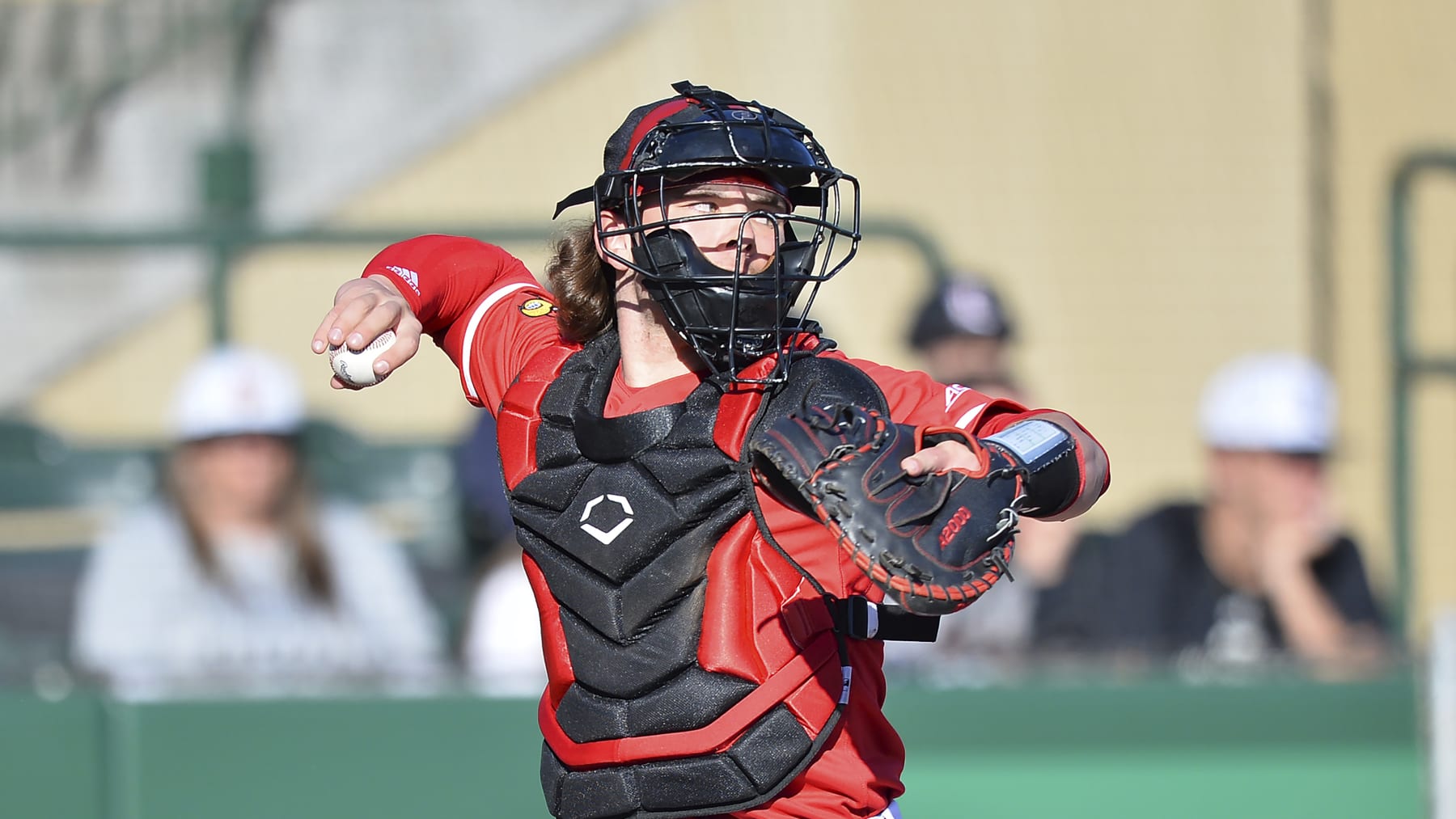
Second Round (No. 40 Overall): Dalton Rushing, C, Louisville
Stuck behind 2021 No. 1 overall pick Henry Davis on the depth chart, Dalton Rushing tallied just 107 plate appearances in his first two seasons at Louisville. However, he turned heads in the Cape Cod League last summer when he hit .314/.401/.542 with six home runs in 142 plate appearances. He followed that up with an 1.156 OPS and 23 home runs this spring, though he did strike out 58 times in 64 games. He has a strong 6'1", 220-pound frame and checks all the boxes to be a solid defensive catcher with more reps behind the plate.
Grade: A
Despite their first pick being moved back 10 spots as a result of exceeding the luxury tax threshold, the Dodgers still walked away with the third-best catcher in the draft class and a player some thought would hear his name called in the first round. The rich get richer.
Miami Marlins
15 of 30
First Round (No. 6 Overall): Jacob Berry, 3B, LSU
Jacob Berry hit .352/.439/.676 with 19 doubles, 17 home runs and 70 RBI as a freshman at Arizona in 2021 before transferring to LSU and continuing to rake as a draft-eligible sophomore. The 6'0", 212-pound slugger again showed some of the best raw power in the nation with 15 home runs and a .630 slugging percentage, and he slashed his strikeout rate from 19.5 to 8.9 percent while facing a tough SEC schedule. Scouts are split on where he'll wind up defensively, though it's unlikely his long-term home is third base. His bat should play anywhere, and first base, right field and designated hitter are potential landing spots.
Grade: B
In a bubble, I like the upside of Cam Collier over the MLB-readiness of Berry, but this Marlins squad is closer to contention than most teams drafting in the top 10, and they need offense, so the pick makes sense.
Second Round (No. 46 Overall): Jacob Miller, RHP, Liberty Union High School (OH)
Behind Brock Porter and Dylan Lesko, Jacob Miller has a strong case for being the best high school right-hander in the 2022 class. The 6'2", 180-pound Ohio prep standout showed improved velocity with his fastball this spring while touching 97 mph, and he backed it up with two distinct breaking pitches in a slower looping curveball and a tight slider. There are some things to smooth out in his delivery, but he's a good enough athlete to believe he can make the necessary adjustments.
Grade: A
An organization that has proven it knows how to develop pitching talent lands one of the best high school pitchers in the draft at No. 46 overall. Well played, Marlins.
Milwaukee Brewers
16 of 30First Round (No. 27 Overall): Eric Brown Jr., SS, Coastal Carolina
Eric Brown stands out for his unique batting stance, which is something of a hybrid between Julio Franco and Craig Counsell. It seems to work just fine as he hit .330/.460/.544 with 28 extra-base hits, though it could need some refining at the next level. He was a Cape Cod League All-Star last summer, which helps alleviate concerns about the level of competition he faced in the Sun Belt Conference. The 5'10", 190-pound infielder should have no problem sticking at shortstop, and he has some sneaky power behind his plus hit tool.
Grade: B-
It's fitting that the guy known for his weird batting stance lands in Milwaukee, where Counsell gets to oversee his development. There were a lot of high-ceiling arms still on the board, and given how well the Brewers have churned out pitching in recent years, it's a bit surprising they didn't go that route.
Second Round (No. 63 Overall): Jacob Misiorowski, RHP, Crowder JC (MO)
Jacob Misiorowski might already be playing pro ball if not for a hamstring injury during his senior season of high school and a torn meniscus that ended his debut season at Crowder JC during his first start. Finally healthy this spring, he went 10-0 with a 2.72 ERA and 136 strikeouts in 76 innings. The 6'7" right-hander gets good extension and has touched 100 mph with his fastball while also showing a plus slider. However, he'll need to add strength to his 190-pound frame, develop his changeup and find more repeatable mechanics to stick as a starter.
Grade: A
The Brewers drafted flame-throwing lefty Antoine Kelly from the JUCO ranks with the No. 65 overall pick in the 2019 draft, and he's now one of the top pitching prospects in their system. They know how to develop this type of player.
Balance Round B (No. 72 Overall): Robert Moore, SS, Arkansas
Moore looked like a lock for the first round after he hit .283/.384/.558 with 16 home runs and 53 RBI during his sophomore season, but he battled through a rough junior campaign. The 5'9" middle infielder finished with a .232 average and saw his OPS plummet by 141 points, though he still walked at a healthy 14 percent clip en route to a .374 on-base percentage. The son of Royals general manager Dayton Moore, he has the intangibles you'd expect from someone who grew up around the game.
Grade: C
I thought Moore played his way out of Day 1 conversation this spring, but his baseball IQ and sophomore numbers were enough for him to slide into the top-80 picks. He feels like a future utility player, and there was more upside elsewhere on the board.
Minnesota Twins
17 of 30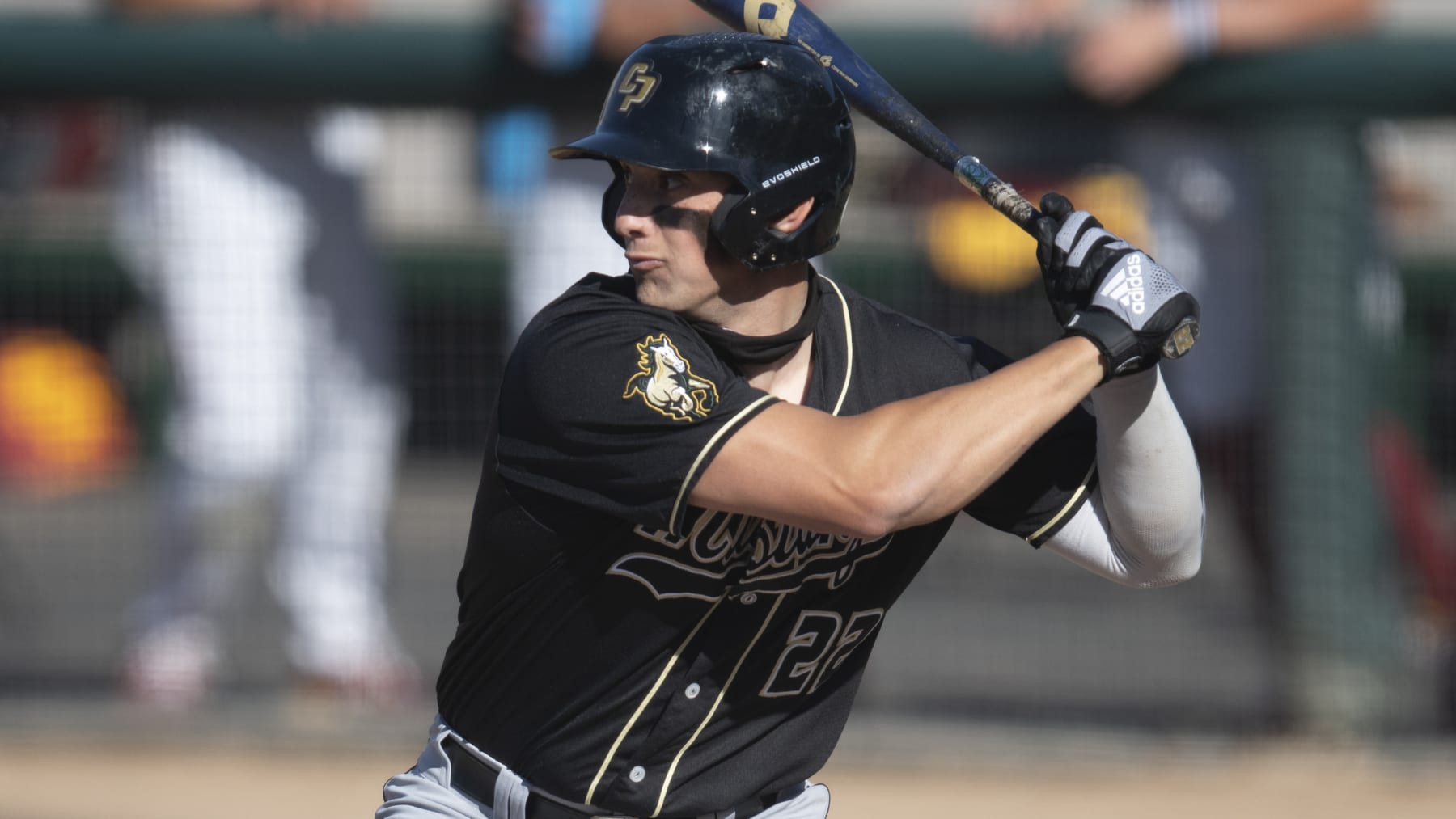
First Round (No. 8 Overall): Brooks Lee, SS, Cal Poly
The No. 38 draft prospect on Baseball America's Top 500 list in 2019, Brooks Lee slid to the 35th round thanks to the well-known fact that he wanted to play for his father at Cal Poly. His stock has steadily climbed during his three years on campus. After hitting .357/.462/.664 with 25 doubles, 15 home runs, 55 RBI and far more walks (46) than strikeouts (28) this spring, he is the top college position player in the 2022 class. The switch-hitter has a potentially elite hit tool with "otherworldly bat-to-ball skills" and plenty of impact potential even with a likely move to second or third base down the line.
Grade: A+
The Twins were rumored to be focusing heavily on college bats, and they wound up with arguably the best one in the draft. An eventual shift away from shortstop will put more pressure on Lee's offensive game, but he's given every reason to believe in it this spring. I'll immediately slot him ahead of Austin Martin on their organizational rankings.
Second Round (No. 48 Overall): Connor Prielipp, LHP, Alabama
Arguably the biggest wild card in the 2022 draft class, Connor Prielipp posted a 0.96 ERA with a 47-to-7 strikeout-to-walk ratio in 28 innings to begin his college career before Tommy John surgery cut his 2021 season short. That left him reliant on bullpen sessions and the Draft Combine to give scouts one final look this spring. With a mid-90s fastball, a lethal slider that sits in the low 90s and is a legitimate 70-grade pitch, and a good feel for a changeup, he has the stuff to be the best pitcher in the 2022 class if he can avoid further arm issues.
Grade: A
The Twins have to be considered one of the biggest winners of Day 1. I truly believe Prielipp can be the best pitcher in this class if everything breaks right, and worst-case scenario, he's an electric left-handed reliever.
Balance Round B (No. 68 Overall): Tanner Schobel, SS, Virginia Tech
After hitting .279/.359/.441 with seven home runs as a freshman starter in 2021, Schobel took a huge step forward this spring. Despite his undersized 5'10", 170-pound frame, he showed surprising pop while batting .362/.445/.689 with 18 doubles, 19 home runs and 74 RBI in 59 games. He has drawn comparisons to Brandon Lowe, and while it remains to be seen if his pull-heavy power will translate to the pro game, there's reason for optimism.
Grade: C
Not my favorite pick of the night for the Twins, but they set the bar high. Will the power translate at the pro level?
New York Mets
18 of 30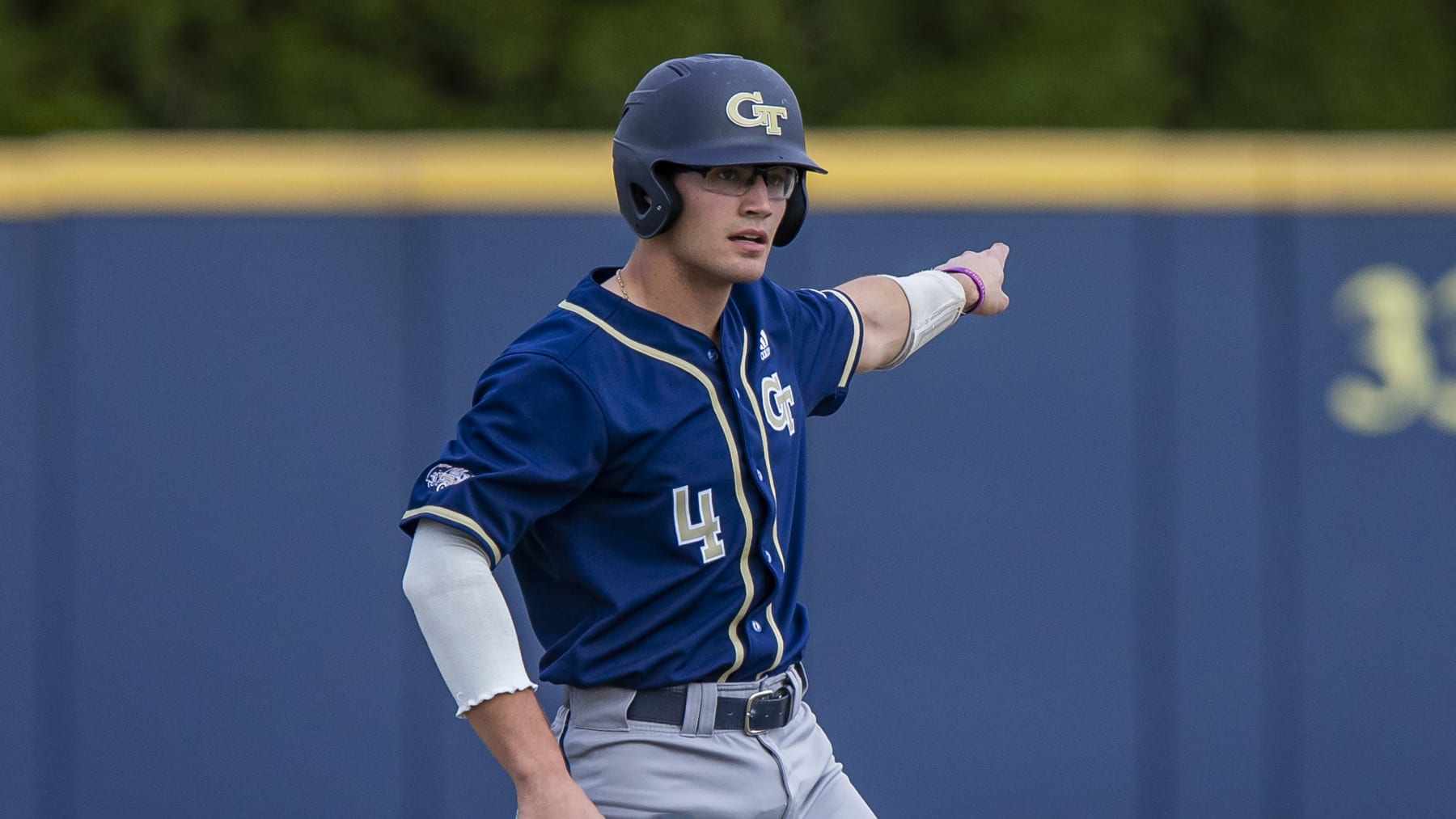
First Round (No. 11 Overall): Kevin Parada, C, Georgia Tech
One of the best offensive players in the country, Kevin Parada hit .361/.453/.709 with 26 home runs and 88 RBI in 60 games as a draft-eligible sophomore this spring at Georgia Tech. He trimmed his strikeout rate (16.9 to 10.5 percent) and improved his walk rate (7.0 to 9.8 percent), giving him one of the most well-rounded offensive profiles in the 2022 class. While he has worked hard to improve defensively, he will likely never be more than an average defender. His middle-of-the-order offensive potential will drive his future value.
Grade: A+
The only real knock on Parada is his defense, and with Francisco Alvarez penciled in as the catcher of the future, that's much less of a concern for the Mets. He can flat-out hit, and with a position change, his bat can be fast-tracked to the majors.
First Round (No. 14 Overall): Jett Williams, SS, Rockwall-Heath High School (TX)
One of the best performers on the showcase circuit last summer, Jett Williams continued to impress this spring, and his stock was still climbing in the weeks leading up to the draft. Despite an undersized 5'8", 175-pound frame, he makes consistent hard contact with great bat speed and good barrel control. Whether his defensive future is at shortstop or in center field, there is little question he's an up-the-middle player who can impact the game with his speed and athleticism as well as his plus hit tool.
Grade: A
Hey-o, nailed it on my mock draft! Williams is the perfect high-ceiling up-the-middle player to pair with the relatively safe first pick of Parada. Always been a fan of the one college player and one high school player approach when teams have two first-round picks.
Second Round (No. 52 Overall): Blade Tidwell, RHP, Tennessee
Blade Tidwell missed the first six weeks of the 2022 season with shoulder soreness and then took several more weeks to ramp up to a starter's workload, but he still showed enough to be considered one of the top college pitchers in the class with a 3.00 ERA and 51 strikeouts in 39 innings. The 6'4", 207-pound right-hander can touch 99 mph with his fastball, but it can straighten out at times and be hittable. His electric fastball-slider combination gives him a high floor as a late-inning reliever, but he'll be given every chance to start.
Grade: A
Tidwell might have been a first-round pick if not for his shoulder issues this spring, and that makes him a great value pick here as the third selection in an already impressive draft class.
Compensation Round (No. 75 Overall): Nick Morabito, OF, Gonzaga College High School (DC)
A pop-up prospect this spring, Morabito has a strong 5'11", 185-pound frame, and he has shown a plus hit tool with a smooth, compact swing and good bat speed. His best present tool is his speed, and it will serve him well defensively in the outfield as he did not have the arm to stick at shortstop after playing the position in high school.
Grade: C+
I like that he was announced as an outfielder rather than trying him out at shortstop and delaying his development. He's a bit of a reach here, but he also had helium all spring.
New York Yankees
19 of 30
First Round (No. 25 Overall): Spencer Jones, OF, Vanderbilt
One of the best two-way prospects in the 2019 draft, Spencer Jones never took the mound at Vanderbilt and missed a significant chunk of the 2021 season recovering from Tommy John surgery. He finally had a chance to play every day this spring and responded by hitting .370/.460/.644 with 21 doubles, 12 home runs and 60 RBI, albeit with a 23.5 percent strikeout rate. The 6'7", 225-pound outfielder is still learning to tap into his power potential, and his swing can get long at times, but the potential is there for him to be an impact offensive player.
Grade: B+
A big 6'7" outfielder still working to tap into his power potential? The Yankees know a thing or two about how to get the most out of a prospect list this. After all, Aaron Judge only hit 18 home runs in 169 games at Fresno State.
Second Round (No. 61 Overall): Drew Thorpe, RHP, Cal Poly
The sea of scouts flocking to see Cal Poly shortstop Brooks Lee this spring also had an opportunity to see Drew Thorpe as the team's Friday starter. The 6'4", 190-pound hurler went 10-1 with a 2.32 ERA, 0.86 WHIP and 149 strikeouts in 104.2 innings to earn All-American honors. His changeup might be the best from this year's college crop, and he pairs it well with a heavy, sinking fastball. He's not overpowering, but his strike-throwing ability and the potential for more as his frame fills out further give him more upside than the average college arm.
Grade: A
The Yankees system is loaded with high-risk, high-reward players in the lower levels of the minors, so grabbing a high-floor pitcher who still has some upside of his own is a nice departure from that profile.
Oakland Athletics
20 of 30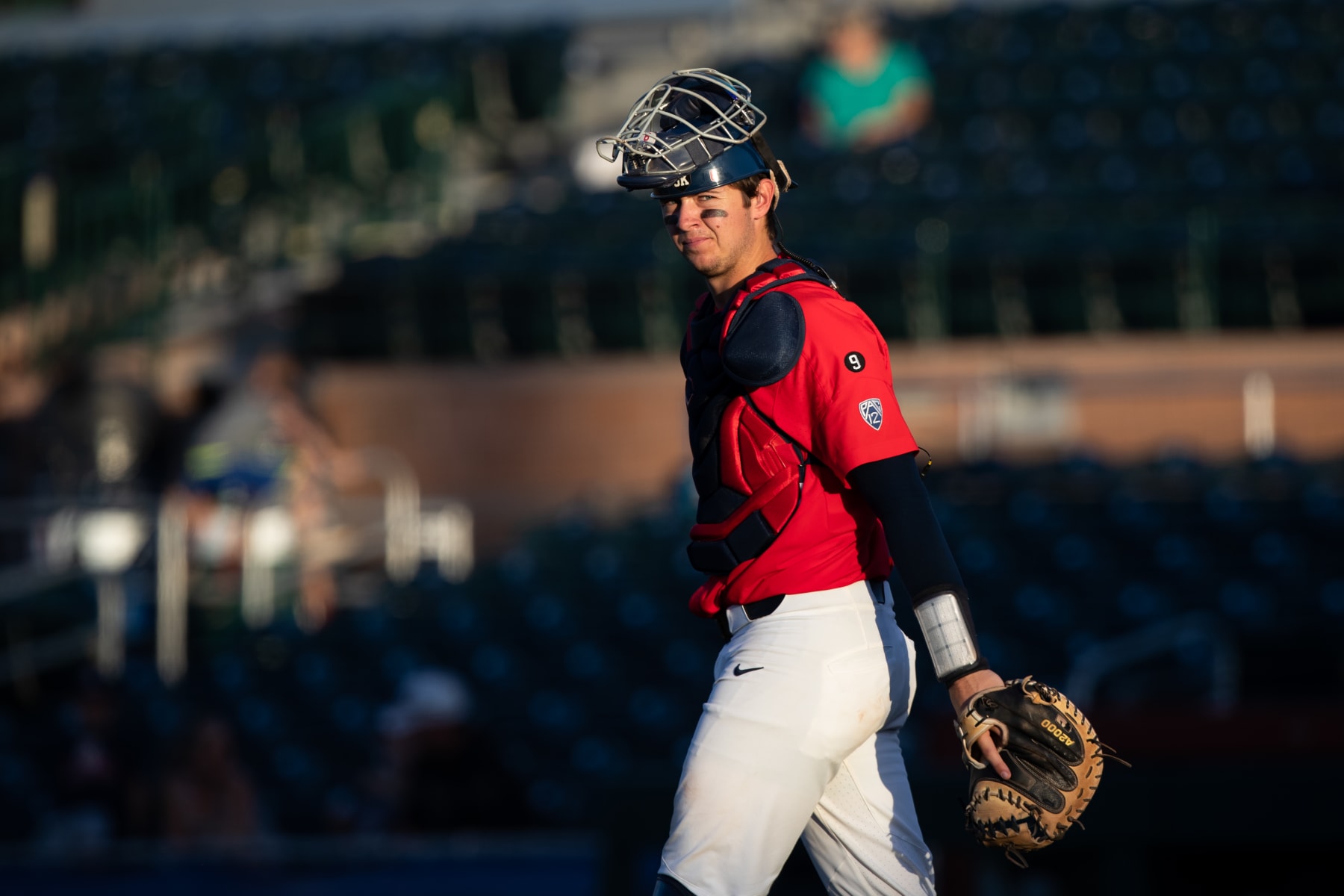
First Round (No. 19 Overall): Daniel Susac, C, Arizona
The National Co-Freshman of the Year in 2021, Daniel Susac followed up his stellar collegiate debut with an even better sophomore season, hitting .366/.430/.582 with 19 doubles, 12 home runs and 61 RBI in 64 games. He has some swing-and-miss to his game, but his all-fields power will play at the next level. Despite a big 6'4" frame, he profiles as a solid defender thanks to a strong arm and polished receiving skills. He doesn't have the same offensive ceiling as Kevin Parada, but he's a more well-rounded catcher.
Grade: A
With Futures Game MVP Shea Langeliers and Tyler Soderstrom rising the ranks and Sean Murphy entrenched in the big leagues, the A's were already loaded with young catching talent. That's a great "problem" to have with a dearth of quality backstops leaguewide, and this is one of the best value picks of the first round.
Second Round (No. 56 Overall): Henry Bolte, OF, Palo Alto High School (CA)
A breakout performance at the Area Code Games last summer put Henry Bolte on the draft prospect map, and he continued to impress throughout the showcase circuit and into his senior season at the same high school program that produced Joc Pederson. The 6'3", 195-pound outfielder has four potential plus tools and one big question mark about whether he will make enough consistent contact to tap into his vast potential. He's a project, but one that could pay off in a big way.
Grade: B-
The A's don't have the best track record of developing toolsy outfielders, most notably whiffing on Austin Beck (No. 6 overall in 2017) and Lazaro Armenteros ($3 million signing bonus in 2016), which gives me some reason for pause here.
Balance Round B (No. 69 Overall): Clark Elliott, OF, Michigan
The top position-player prospect in the Big Ten this season, Elliott hit .337/.460/.630 with 17 doubles, 16 home runs and 19 steals in 23 attempts. Some question the sustainability of his extreme spike in power production (.428 to .630 slugging percentage), but his strong hit tool and smooth left-handed swing have drawn comparisons to Michael Brantley. Even if he winds up being a contact-over-power guy, his speed and outfield defense give him a high floor.
Grade: A
Big Ten prospects are often overlooked, but Elliott has some of the best all-around tools of any outfielder in the class, and even if the power doesn't play, he provides value in a variety of ways.
Philadelphia Phillies
21 of 30First Round (No. 17 Overall): Justin Crawford, OF, Bishop Gorman High School (NV)
One of the best all-around athletes in the 2022 class, Justin Crawford also has some of the best bloodlines as the son of former All-Star Carl Crawford. While elite speed and solid center field defense are his best present tools, his 6'3", 175-pound frame holds significant offensive upside, and he has been steadily climbing draft boards. He has good bat-to-ball skills and uses his speed well, but he will need to refine his contact-oriented approach if he is going to be more than a slap-and-dash hitter.
Grade: A
I preach over and over again this time of year that teams don't draft for need in the MLB draft, but it's still nice to see the Phillies take a center fielder. Crawford's stock was on the rise all spring, and it's hard to argue with those bloodlines.
Pittsburgh Pirates
22 of 30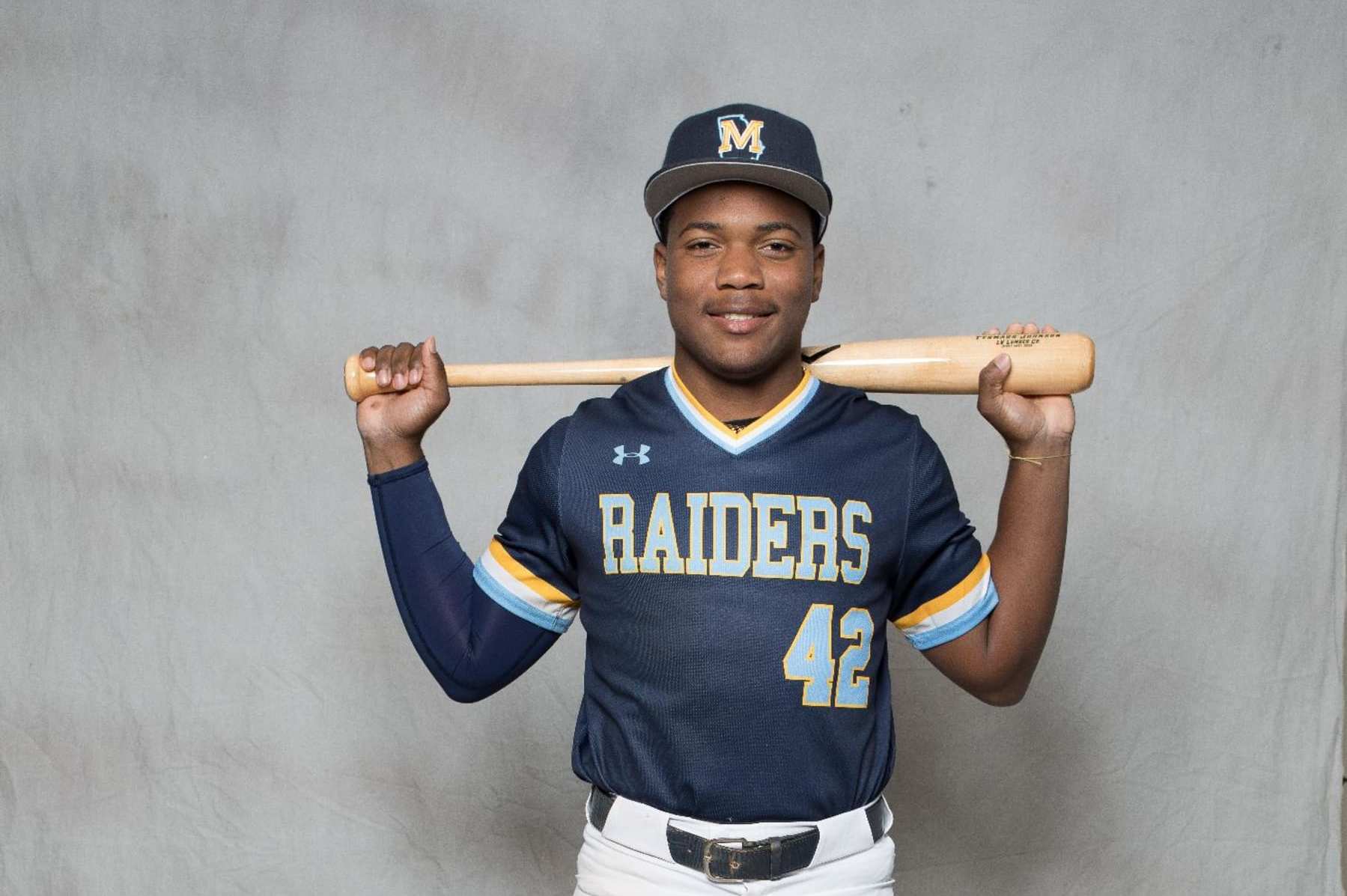
First Round (No. 4 Overall): Termarr Johnson, SS, Mays High School (GA)
Termarr Johnson has the tools to be a generational talent in the batter's box. One scout called his offensive game "a combination of Wade Boggs' plate discipline and Vladimir Guerrero Sr.'s bat-to-ball skills" (via MLB.com). He also has significant power in his generously listed 5'10", 175-pound frame thanks to his bat speed and elite ability to find the barrel. If he were a no-doubt shortstop, he would be the No. 1 player in this draft class, but an average arm and limited range likely mean a shift to second base. From his performance on the showcase circuit last summer to his play with Team USA, he has proved time and again he can flat-out hit.
Grade: A
Johnson is a high-floor, high-ceiling player who can be a cornerstone piece of the next contending Pirates team along with 2021 top pick Henry Davis and rising star Oneil Cruz. This is going to be a fun team in a few years.
Balance Round A (No. 36 Overall): Thomas Harrington, RHP, Campbell
Scouts had plenty of opportunities to see Thomas Harrington while scouting Campbell shortstop Zach Neto, and he made the most of it this spring by going 12-2 with a 2.53 ERA, 0.94 WHIP and a 111-to-18 strikeout-to-walk ratio in 92.2 innings. With four playable pitches—including a plus changeup—and good command, he has a great foundation to build on as a high-floor starter. Harrington also offers more physical projection than most college pitchers with a 6'2", 185-pound frame that is far from maxed out.
Grade: B+
The Pirates grabbed one of the highest ceilings in the draft class at No. 4 overall, and now they go with a high-floor pitcher who should shoot through the minors toward his middle-of-the-rotation ceiling. Great approach.
Second Round (No. 44 Overall): Hunter Barco, LHP, Florida
Ranked No. 32 on Baseball America's Top 500 prospect list before the 2019 draft, Hunter Barco made it onto campus and threw the ball well as a freshman in 2020 before the season was abruptly cut short. He was a regular in the Florida rotation last season, going 10-3 with a 4.01 ERA in 83 innings, and he was off to an even better start this spring with a 2.50 ERA, 0.89 WHIP and 12.3 K/9 in 50.1 innings before when he was shut down with elbow discomfort. He ultimately joined a long list of pitchers to undergo Tommy John surgery in May.
Grade: B
If Barco's start to the 2022 season was any indication, he's on his way to delivering on the hype that followed him out of high school. After taking a safe, high-floor college arm with their last pick, they go with more of a risk-reward selection here to round out a nice Day 1 haul.
San Diego Padres
23 of 30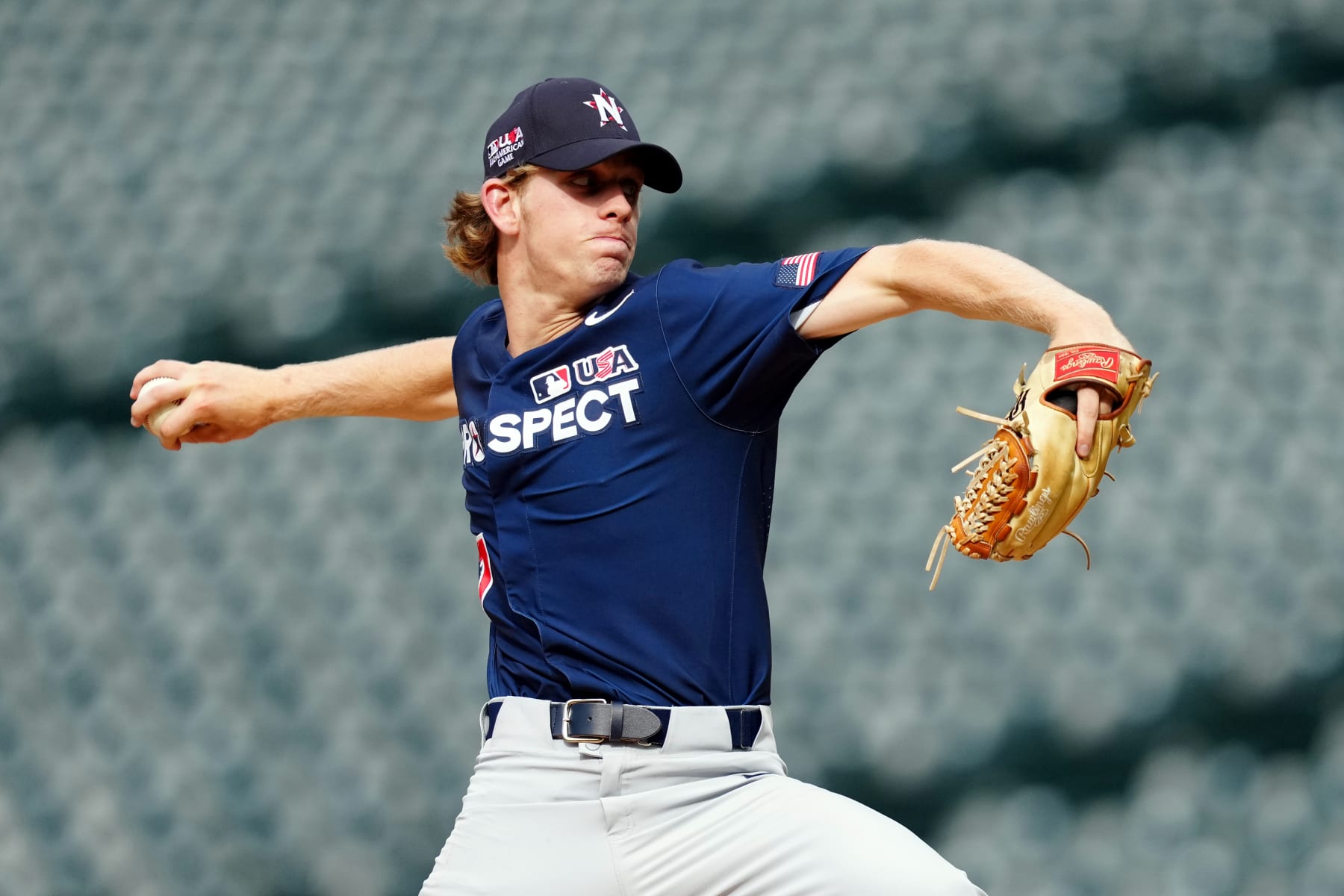
First Round (No. 15 Overall): Dylan Lesko, RHP, Buford High School (GA)
Dylan Lesko was a legitimate candidate to go No. 1 overall before an elbow injury shut him down in April and eventually led to Tommy John surgery. The 6'2", 195-pound right-hander was the first junior ever to win Gatorade National Player of the Year honors in 2021 when he went 11-0 with a 0.35 ERA and 112 strikeouts in 60 innings. He pitches off a mid-90s fastball and one of the best changeups at any level of organized baseball, and he can also spin a decent curveball though it's an inconsistent third offering. He could be the steal of the draft if he returns to pre-injury form without any setbacks.
Grade: A+
Two in a row on my mock draft! The Padres took a chance on Cal Quantrill with the No. 8 overall pick in the 2016 draft when he was recovering from Tommy John surgery, so they're no stranger to this type of risk. This could be the steal of the draft.
Balance Round A (No. 39 Overall): Robby Snelling, LHP, McQueen High School (NV)
A 4-star football recruit who played quarterback and linebacker, Robby Snelling has a physical 6'3", 210-pound frame, and he uses his athleticism well on the mound with smooth mechanics and clean arm action. He sits consistently in the mid-90s with his fastball and backs it with a high-spin curveball that has the potential to be a putaway pitch. His changeup needs further refinement to be a viable third offering, but his overall pitchability belies his split focus. He could really take off once he turns his full attention to the baseball diamond.
Grade: A
In one of my earlier mock drafts this spring, I had Snelling going to the Padres at No. 15 overall, and it was a surprise to see him still on the board at the end of the first round. A great job restocking the system on Day 1 after several top prospects moved onto the majors this season.
Second Round (No. 53 Overall): Adam Mazur, RHP, Iowa
The top draft prospect in the Big Ten Conference this year, Adam Mazur went 7-3 with a 3.07 ERA, 0.96 WHIP and 98 strikeouts in 93.2 innings. His draft stock started to climb last summer when he posted a 1.55 ERA and 34 strikeouts in 29.0 innings in the Cape Cod League, and he transferred to Iowa from South Dakota State for the 2022 season. The 6'2" right-hander can touch 99 mph with his four-seam fastball, and he also throws a sinker, slider, curveball and changeup. If the gains he's made this spring are for real, he could be one of the steals of the 2022 draft.
Grade: B+
Another big-time upside play for a Padres team that loves to bet on potential.
San Francisco Giants
24 of 30First Round (No. 30 Overall): Reggie Crawford, LHP/1B, UConn
Reggie Crawford hit .295/.349/.543 with 13 home runs and 62 RBI as a first baseman in 2021, but it's his upside on the mound that made him a potential first-round pick prior to undergoing Tommy John surgery last fall. He touched 100 mph with his fastball and showed a nasty slider while pitching for Team USA last summer, but he only threw eight total innings in his two seasons at UConn, making him a huge roll of the dice. With three years of college eligibility remaining, he recently transferred to Tennessee and could bet on himself with a return to campus.
Grade: A
The Giants announced Crawford as a two-way player, which will be fun to watch unfold as he begins his pro career. Even if he does eventually turn his full attention to pitching, his stuff stacks up to any pitcher in the 2022 class if he can return to his pre-injury form, and at No. 30 overall, the upside here is worth the risk.
Second Round (No. 66 Overall): Carson Whisenhunt, LHP, East Carolina
After posting a 3.77 ERA with 79 strikeouts in 62 innings in 2021, Carson Whisenhunt was expected to be one of the top college pitchers in the country. Instead, he was suspended for the entire 2022 season following a positive test for a performance-enhancing drug after he claimed he took supplements purchased from a nationwide nutrition store. He did make four starts in the Cape Cod League, and while the results weren't great, his stuff was as good as ever, including his elite changeup. He has a middle-of-the-rotation ceiling with a very high floor.
Grade: A+
Outside of Brock Porter, this was the most surprising slide of Day 1 for me. Despite his inactivity this spring and rocky Cape Cod League showing, he still has the potential to be the best arm in this class.
Seattle Mariners
25 of 30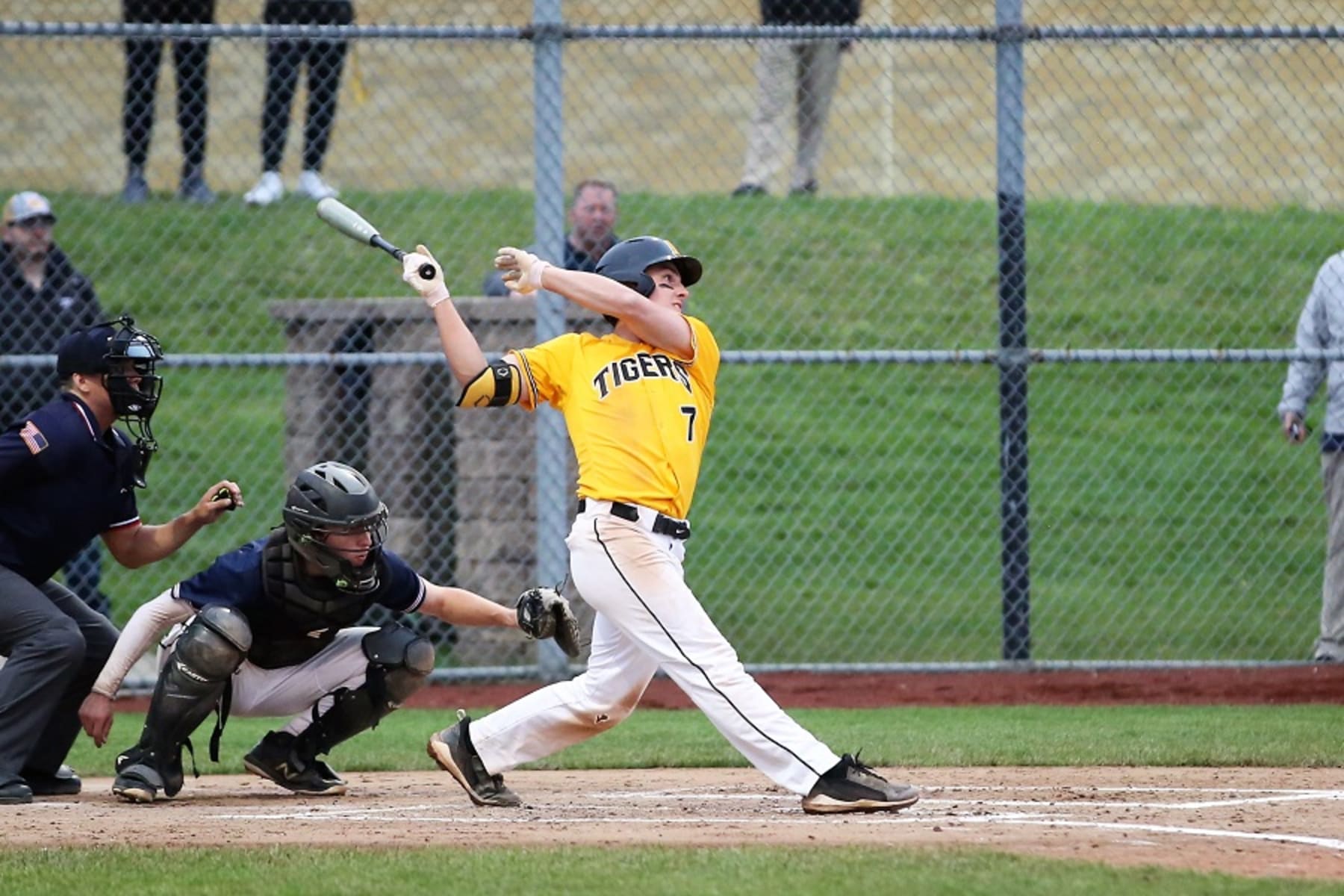
First Round (No. 21 Overall): Cole Young, SS, North Allegheny High School (PA)
Cole Young does not have the same loud carrying tools as some of the other top high school prospects in the 2022 class, but he's a well-rounded shortstop with an extremely high floor thanks to his overall polish. His compact left-handed swing and good bat-to-ball skills give him a plus hit tool, and he pairs that with above-average speed while checking all the boxes to be a solid defensive shortstop at the next level. He has been compared to Adam Frazier with more extra-base pop, and that profile holds plenty of future value.
Grade: B+
There's no such thing as too much middle infield talent, and after hitting on Edwin Arroyo with their second-round pick in last year's draft, the M's add another quality shortstop from the prep ranks. Are we seeing a new trend after years of scouring the college ranks?
Second Round (No. 58 Overall): Tyler Locklear, 3B, VCU
One of the best power hitters in this year's college class, Tyler Locklear batted .402/.542/.799 with 25 doubles, 20 home runs and 78 RBI in 62 games this spring. There are some questions about his hit tool, and he struck out 32 times in 141 plate appearances in the Cape Cod League last summer facing high-level competition. He has a chance to stick at third base as a pro, but first base is a more likely long-term home, putting even more pressure on his right-right offense-only profile.
Grade: A
There were rumblings that Locklear could sneak into the back end of the first round after his big spring, and the Mariners still found a way to get the productive college bat they so often target, even after going the high school route in the first round.
Balance Round B (No. 74 Overall): Walter Ford, RHP, Pace High School (FL)
Walter Ford won't turn 18 until December, but he reclassified from 2023 following a strong performance on the summer showcase circuit. The 6'2", 198-pound righty has been up to 97 mph with his fastball, with good late life, and he complements it with a plus slider. He'll also need to find a viable third pitch in pro ball and clean up his mechanics to repeat his delivery more consistently. A good overall athlete, there's a good chance he would be a two-way player as a power-hitting infielder if he honors his commitment to Alabama.
Grade: B
A prep infielder with good all-around tools, a high-floor college bat and a high-ceiling prep pitcher. A solid, well-balanced Day 1 for a Mariners team that has drafted extremely well in recent years.
St. Louis Cardinals
26 of 30
First Round (No. 22 Overall): Cooper Hjerpe, LHP, Oregon State
Cooper Hjerpe used a deceptive crossfire delivery and a polished three-pitch mix to carve up college hitters this spring, racking up a Division I-leading 161 strikeouts in 103.1 innings while going 11-2 with a 2.53 ERA. His stuff is not overpowering, with a fastball that sits in the low 90s and two solid offspeed pitches delivered from a low three-quarters arm slot. That limits his overall ceiling to somewhere in the middle of an MLB rotation, but he's the prototypical high-floor college lefty with advanced pitchability who should move quickly through the minors.
Grade: A
The Cardinals have a long history of drafting high-floor college arms in the first round—Marco Gonzales (No. 19 in 2013), Luke Weaver (No. 27 in 2014), Dakota Hudson (No. 34 in 2016), Griffin Roberts (No. 43 in 2018), Zack Thompson (No. 19 in 2019) and Michael McGreevy (No. 18 in 2021) all fit the mold. Don't be surprised if Hjerpe is the first pitcher from the 2022 class to reach the majors.
Second Round (No. 59 Overall): Brycen Mautz, LHP, San Diego
Used almost exclusively as a reliever during his first two seasons at San Diego, Brycen Mautz moved into the rotation this spring and went 10-2 with a 3.87 ERA and 129 strikeouts in 90.2 innings. The 6'3" southpaw showed improved command while cutting his walks per nine innings from 4.7 to 2.2, and he does a good job inducing groundballs with a heavy low 90s fastball and plus slider. His changeup is still a work-in-progress as a viable third pitch, but his stock is on the rise, and a return to the bullpen is a solid fallback.
Grade: C
I don't understand why this pick wasn't Carson Whisenhunt if they wanted a college lefty with a risk-reward profile. The Cardinals know pitching, but this feels like a reach.
Tampa Bay Rays
27 of 30First Round (No. 29 Overall): Xavier Isaac, 1B, East Forsyth High School (NC)
With a 6'4", 240-pound frame, it's hard to believe that North Carolina prep standout Xavier Isaac is only 18 years old. He missed the bulk of his junior season and all of last summer's showcase circuit with a foot injury, making him one of the bigger wild cards in the draft, but there's a lot to like about his smooth left-handed swing, excellent bat speed and his plus raw power. He's a below-average athlete with a first-base-only defensive profile, so he'll need to hit his way to the big leagues.
Grade: D
The Rays are generally smarter than the rest of the league when it comes to talent recognition and development, but this one is a head-scratcher. Even without the injury, prep players with a first-base-only profile are extremely risky. This should save them a ton of money, so maybe they already have something lined up for their second pick.
Second Round (No. 65 Overall): Brock Jones, OF, Stanford
An excellent athlete who played safety for the Stanford football team as a freshman before focusing exclusively on baseball, Brock Jones turned in a 21-homer, 16-steal junior season while hitting .324/.451/.664 and showing the defensive tools to potentially stick in center field. His 24.6 percent strikeout rate is a red flag, and he's more or less maxed out physically, but his raw physical tools are enough to dream on his power-speed potential if he can make the necessary adjustments.
Grade: C+
That strikeout rate is difficult to ignore, even if it does come with some excellent surface-level numbers. After an extremely risky first-round pick, there were safer options on the board to provide some balance.
Balance Round B (No. 70 Overall): Chandler Simpson, SS, Georgia Tech
With 80-grade speed and a 20-grade power tool, Simpson is a unique prospect in today's power-centric game. He hit .434/.506/.517 with 27 steals and 64 runs scored in 47 games this spring, striking out just 16 times in 241 plate appearances while tallying just 12 extra-base hits and one home run. He is likely destined for center field defensively, and he's going to be a fascinating prospect to watch develop in the coming years.
Grade: C
I love this pick for a Rays team that is currently developing a somewhat similar player in Xavier Edwards, but I also think he still would have been on the board for Tampa's next pick at No. 104 in the third round.
Balance Round B (No. 71 Overall): Ryan Cermak, OF, Illinois State
The best defensive center fielder in the 2022 draft class not named Druw Jones, Ryan Cermak hit .340/.441/.696 with 19 home runs this spring while showing a more patient approach at the plate. He has plus speed and great instincts in the outfield, and he has also been up to 95 mph off the mound, so he has plenty of arm strength. He raised his walk rate from 8.4 to 13.1 percent this spring and did a better job of laying off pitches out of the zone, allowing him to better tap into his offensive potential.
Grade: B
Few teams value defense as highly as the Rays, so it's not surprising to see them jump at Cermak, who could be their next Kevin Kiermaier if everything breaks right.
Texas Rangers
28 of 30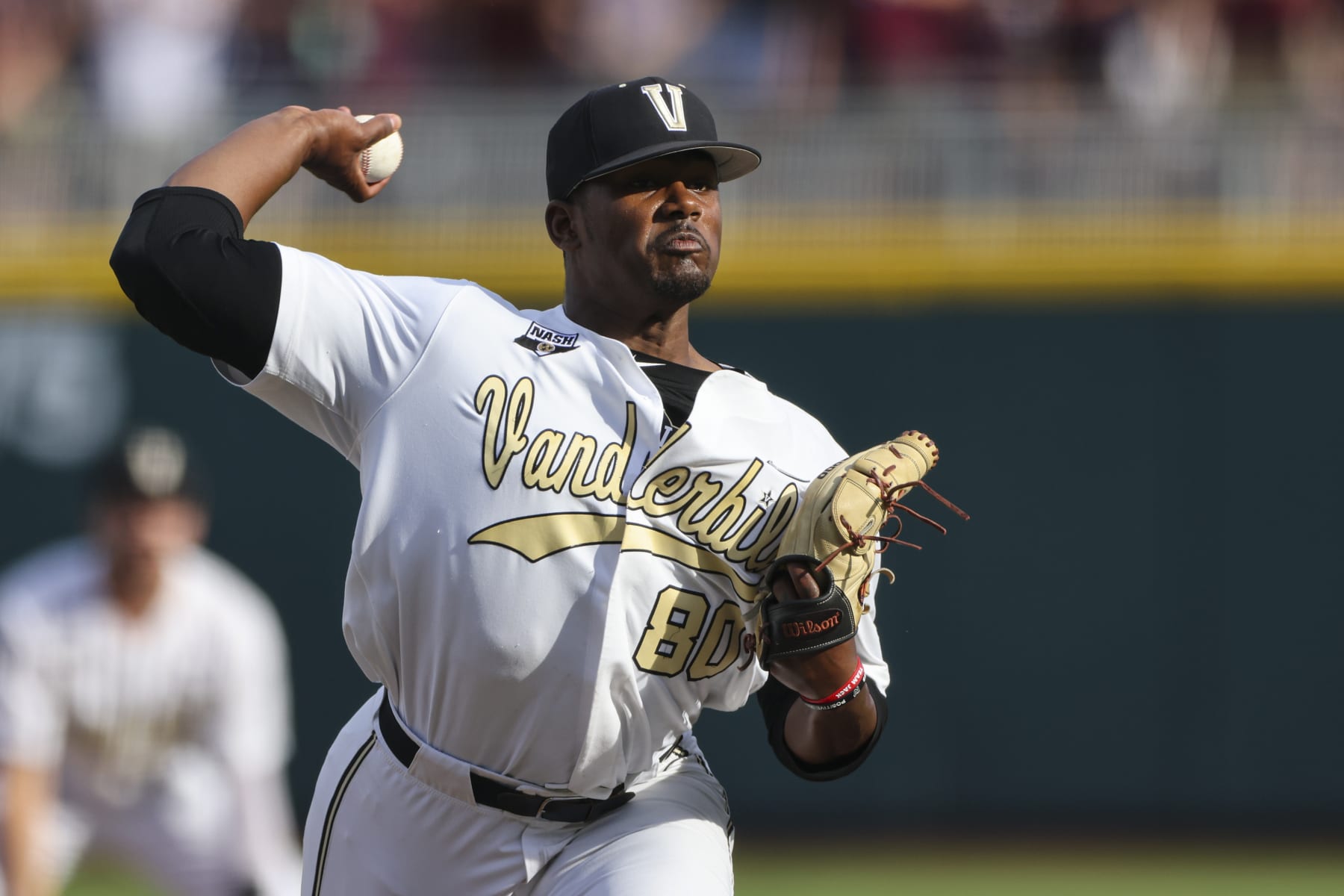
First Round (No. 3 Overall): Kumar Rocker, RHP, Tri-City ValleyCats
The Mets agreed to terms on a $6 million signing bonus with Kumar Rocker as the No. 10 overall pick in the 2021 draft but pulled back their offer when undisclosed concerns about his elbow and shoulder surfaced. Rather than return to Vanderbilt, where he posted a 2.89 ERA and racked up 321 strikeouts in 236.2 innings in three seasons, he sat out the 2022 season before signing with the indy ball Tri-City ValleyCats for what amounted to a five-start showcase. The power stuff and ace upside are still there, but it's been a strange process to get to this point.
Grade: C
Wow. The Rangers only had one Day 1 pick after signing Marcus Semien and Corey Seager, and they swung for the fences. Rocker comes with obvious risk after his deal with the Mets fell through over arm concerns, but his stuff is still electric if he stays healthy. How did he improve his draft stock by seven slots by essentially sitting out a year?
Toronto Blue Jays
29 of 30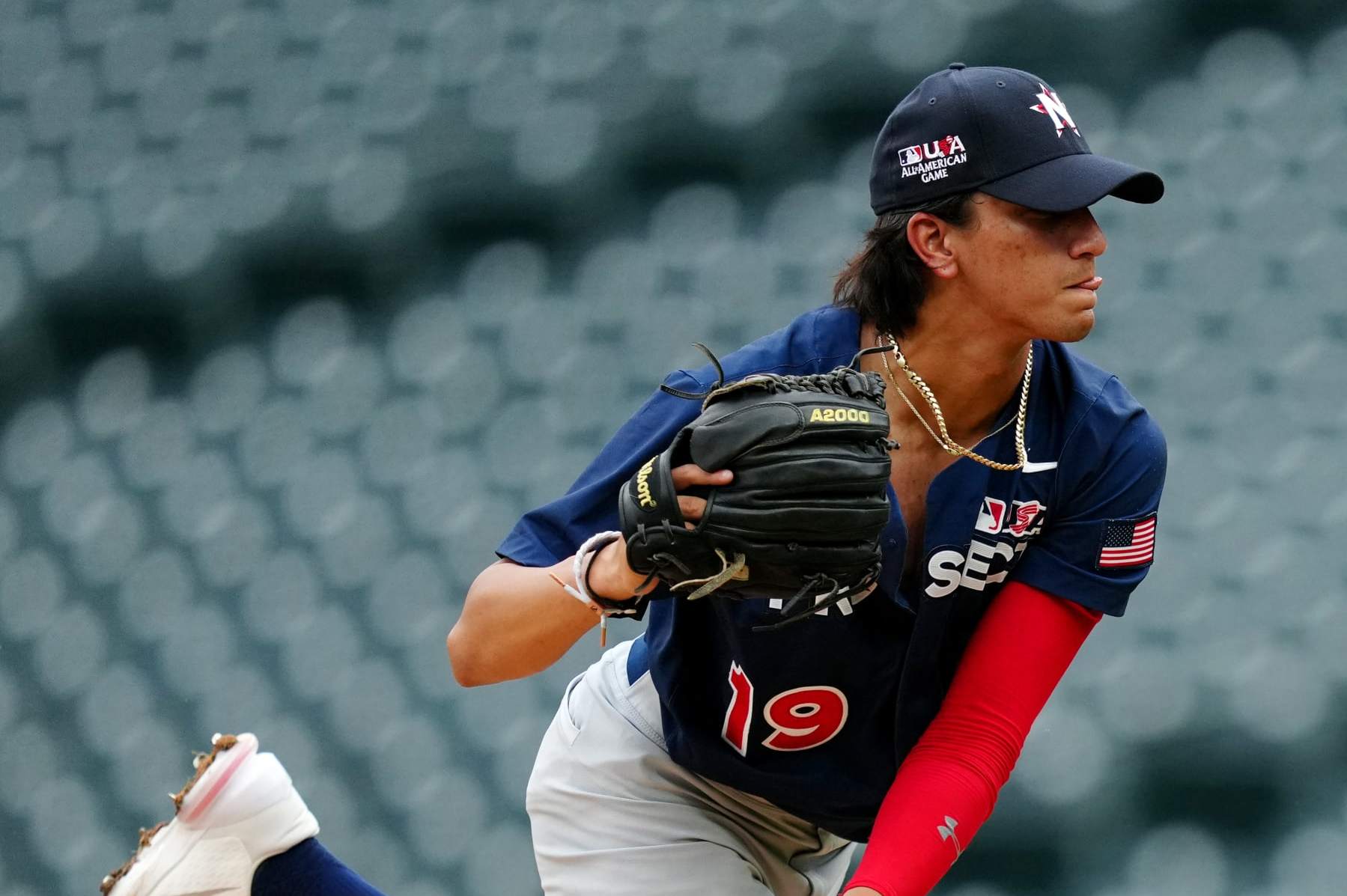
First Round (No. 23 Overall): Brandon Barriera, LHP, American Heritage High School (FL)
With a 6'2", 180-pound frame, Brandon Barriera doesn't offer much in the way of physical projection, but his present stuff is more than enough to make him one of the top high school arms in a thin class. His fastball touches 99 mph, and he backs it with a slider and changeup that both already rate as above-average pitches with plus potential. He also throws a ton of strikes and goes right after hitters, giving him every opportunity to be a starter at the highest level.
Grade: B
The Blue Jays were in a prime position to snag a highly-touted prep pitcher who slid, but why not Brock Porter? Barriera doesn't offer the same future projection, but his present stuff still makes him one of the best high school arms in the class.
Second Round (No. 60 Overall): Josh Kasevich, SS, Oregon
One of the best defensive shortstops in the 2022 class, Josh Kasevich made just 14 errors in 130 games at Oregon while showing a strong arm and smooth actions. He hit .310/.383/.445 with 18 extra-base hits this spring, striking out just 16 times in 277 plate appearances. The 21-year-old may never have more than gap power, but his strong glovework and excellent contact skills will help drive his value at the next level.
Grade: C
It's interesting to see the Blue Jays place an emphasis on defense up the middle, as that has not been a priority in the players they have targeted at that position in years past. Will he make enough of an impact offensively to be more than a utility player?
Compensation Round (No. 77 Overall): Tucker Toman, SS, Hammond High School (SC)
A polarizing prospect entering the 2022 season after looking overmatched at times on the showcase circuit last summer, Tucker Toman cemented his status as one of the better hitters in the high school class with a strong senior campaign. The 6'1", 190-pound switch-hitter has shown the potential for above-average hit and power tools, especially when he doesn't get pull-happy chasing home runs. He could end up at second base, third base or in the outfield defensively, but his bat will carry him as a pro.
Grade: A+
Toman was a popular mock draft pick for the Blue Jays at No. 23 overall, so tip of the cap to them for sliding him this far. It's going to take an above-slot deal, but the Kasevich pick will help make that possible.
Compensation Round (No. 78 Overall): Cade Doughty, 2B, LSU
A proven performer in the SEC, Cade Doughty hit .301/.379/.541 with 31 doubles, 30 home runs and 124 RBI in 133 games at LSU. He has added 20 pounds during his college career, growing into average power to go along with his plus hit tool and advanced approach. He may fit best as a super-utility guy at the next level after seeing time at second base, shortstop and third base this spring, with second base the most natural fit for his defensive profile.
Grade: A
It's hard to argue with that level of production in the SEC, even if there's no clean fit defensively. Nice way to round out a great Day 1 haul.
Washington Nationals
30 of 30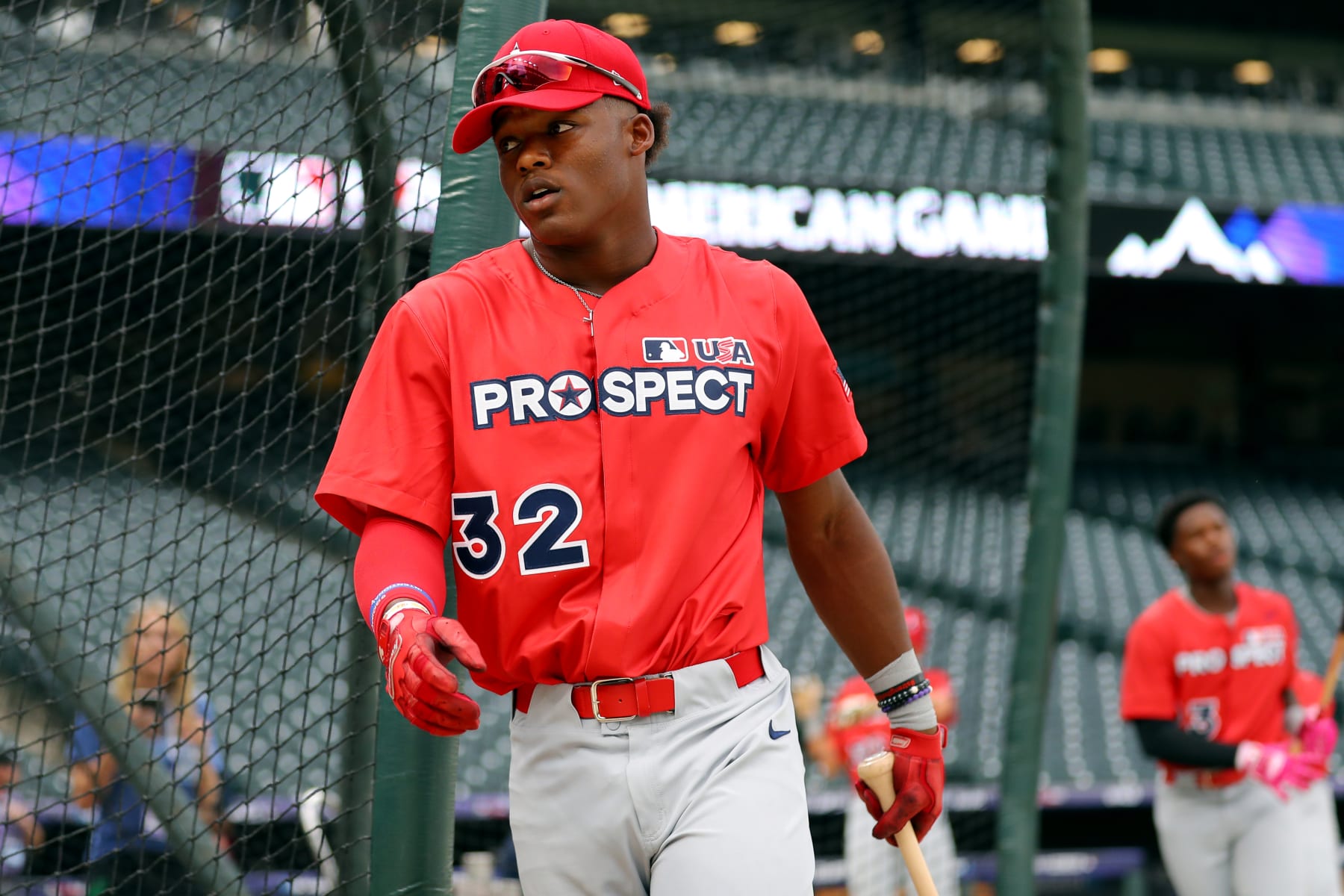
First Round (No. 5 Overall): Elijah Green, OF, IMG Academy (FL)
With a rare 70-power/70-speed profile from Baseball America, Elijah Green might have the highest ceiling of any player in the 2022 draft class. However, there are significant questions about his hit tool, particularly his ability to catch up to velocity up in the zone and to recognize breaking stuff. The son of Pro Bowl tight end Eric Green, he has an athletic 6'3", 225-pound frame that belies his youth, and one could make a strong case that he has the best power tool in the 2022 draft class. He comes with a lot of risk, but he has legitimate superstar upside if everything clicks.
Grade: A
With Juan Soto on his way out the door, the Nationals hope they've found their next superstar in Green. There's a ton of risk here, but it's the perfect risk to take for a team searching for a long-term identity.
Second Round (No. 45 Overall): Jake Bennett, LHP, Oklahoma
Jake Bennett went 10-4 with a 3.69 ERA, 1.09 WHIP and 133 strikeouts in 117 innings as the Friday night starter for an Oklahoma team that reached the College World Series Finals. He has three quality pitches, the best of the bunch being a plus changeup that makes him more effective against righties than lefties. With a 6'6", 234-pound frame, he has the potential to be a workhorse in the majors, though he's more floor than ceiling and likely fits best at the back of an MLB rotation.
Grade: B-
Bennett had some first-round buzz, so this is a good get for a thin Nationals farm system, but I would have loved to see them take a risk on someone with a higher ceiling like Connor Prielipp or Blade Tidwell.
All stats courtesy of Baseball Reference.





